Make the most of your visit to the Eternal City with these famous landmarks in Rome.
Rome, the so-called Capital of the World, is one of the most recognisable cities in Italy. From the awe-inspiring dome of St. Peter’s Basilica to echoes of Ancient Rome at the Colosseum, it has enough attractions to last several visits.
But which of Rome’s famous buildings, monuments and churches should you see if you only have a few days there?
This is where I can help you. Based on multiple visits to the Eternal City and local knowledge, I have put together a list of my favourite Rome landmarks.
Many of these will be familiar; others less so. But collectively they paint a picture of one of the greatest cities in the world.
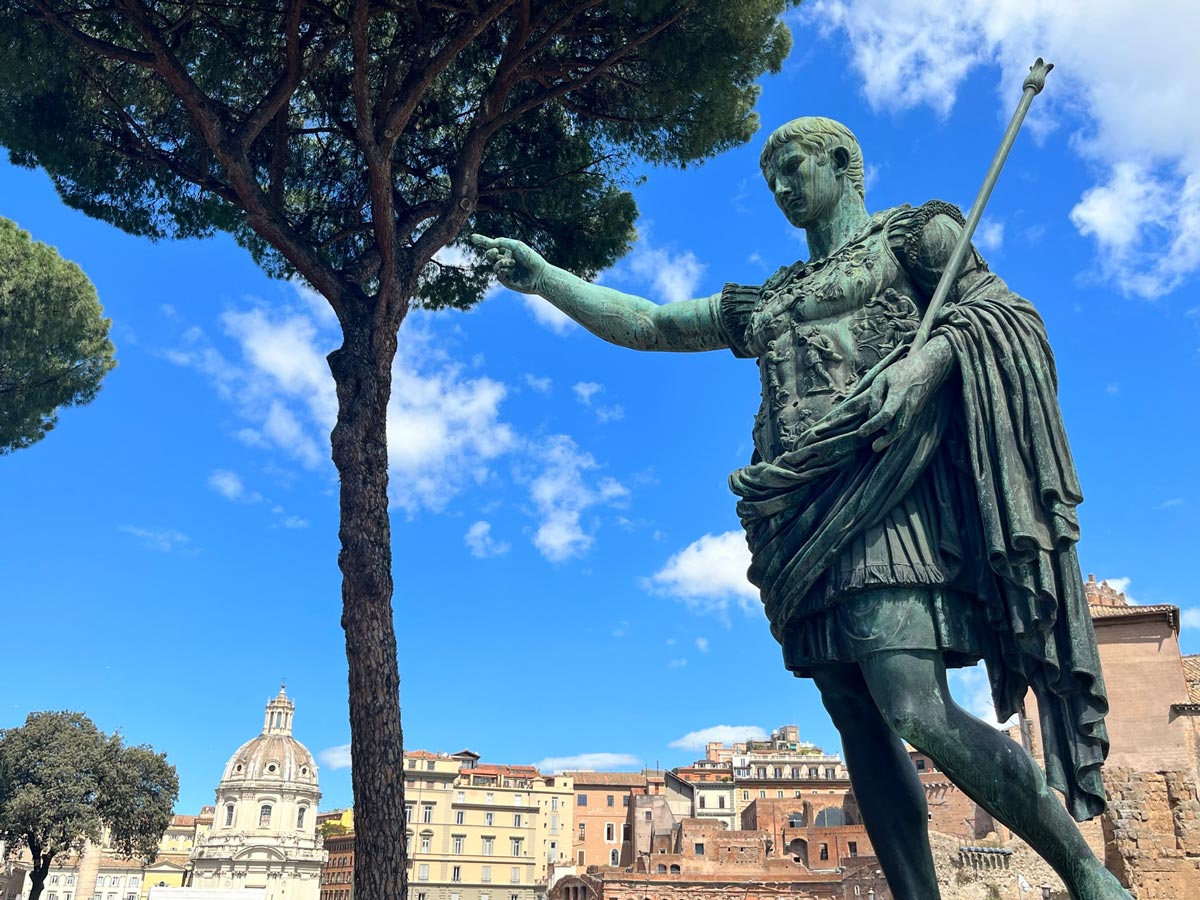
Some articles on this website contain affiliate links. This means that I may earn a small commission if you make a purchase through these links. As an Amazon Associate, I earn from qualifying purchases. Read the full disclosure here.
I’VE WRITTEN THIS ITALY SOLO TRAVEL GUIDE!
A 100+ page ebook to inspire and equip solo travellers with the confidence and knowledge to explore Italy independently
- Plan Your Trip – with curated itineraries, budgeting and how to get around
- Explore Awesome Destinations – guides to the must-see cities of Rome, Florence, Venice and Naples
- Stay Safe as a Solo Traveller – practical safety advice, empowering you to confidently navigate Italy and avoid common pitfalls
- Enjoy Eating Out in Italy – essential tried-and-tested solo dining tips
Famous Landmarks of Rome at a Glance
There is no shortage of landmarks in Rome. The challenge is whittling them down to a manageable list.
To make life easier, I have created six categories to group these very best attractions in Rome. But if you prefer to organise your sightseeing by geographical area, there’s a map at the end of this section that you can use to find these fabulous Rome landmarks.
Iconic Rome landmarks
- Colosseum
- Pantheon
- St. Peter’s Basilica
- Trevi Fountain
- Spanish Steps
- Piazza Navona
- Piazza del Popolo
- Castel Sant’Angelo
- Vitorrio Emmanuel II Monument
- Campo di Fiori
Famous buildings and ruins of Ancient Rome
- Roman Forum
- Arch of Constantine
- Trajan’s Forum
- Largo de Torre Argentina
- Circus Maximus
- Baths of Caracalla
- Via Appia and the catacombs
- Ara Pacis
- Ostia Antica
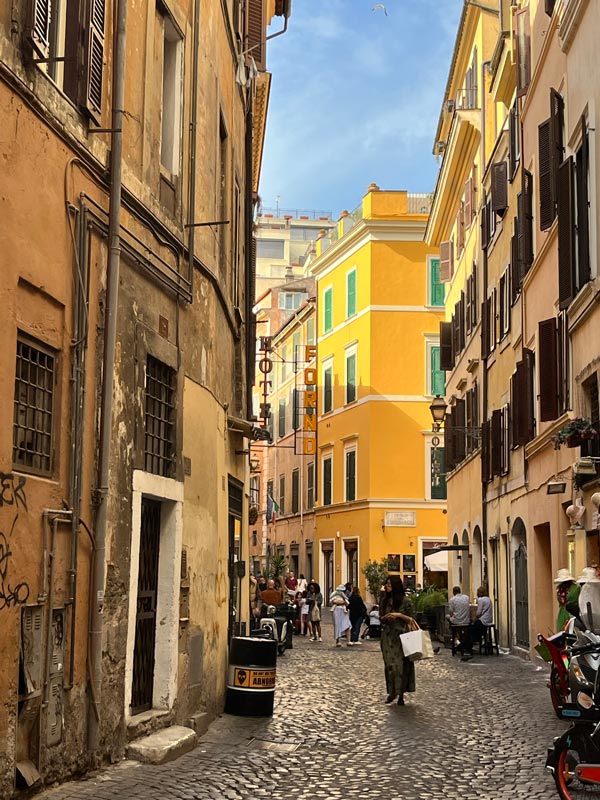
Famous museums & galleries in Rome
- Vatican Museums
- Capitoline Museums
- Galleria Borghese
- Doria Pamphilj Gallery
Famous churches and other places of worship in Rome
- Santa Maria Maggiore
- St. John Lateran
- San Pietro in Vincoli
- San Clemente
- Santa Maria del Popolo
- Great Synagogue of Rome
Gorgeous gardens in Rome
- Villa Borghese Gardens
- Orange Garden
- Rose Garden
Quirky Rome landmarks
- La Bocca della Verità
- Capuchin Crypt
- Stadio dei Marmi
- EUR
If you find it helpful to plan your sightseeing route, here’s my map showing the locations of these famous landmarks in Rome. For an interactive map, simply click here or on the image itself.
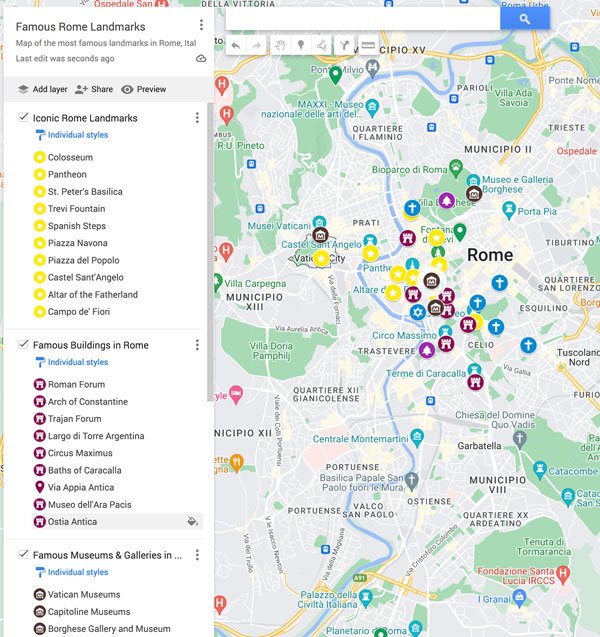
Iconic Landmarks in Rome
Let’s go straight to the top (not that it’s a contest). Here are iconic landmarks that are synonymous with Rome itself.
1. Colosseum (Colosseo)
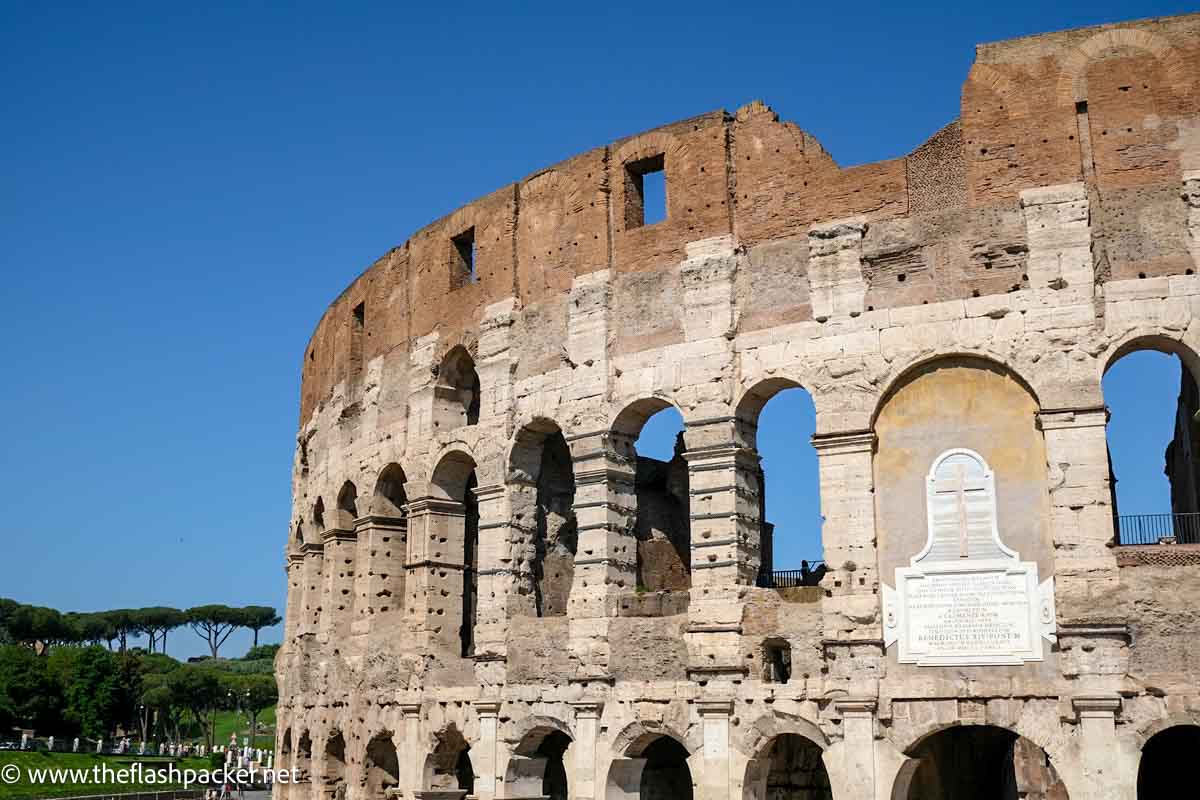
No other monument in Rome can rival the majesty of the Colosseum. It is not only a symbol of the city but is one of the things for which Italy is famous.
Inaugurated in 80 AD with a gala that saw 5,000 animals slaughtered in a single day, this 55,000-seat stadium hosted armed combat for over 500 years. Criminals and slaves, women and dwarves; they were all fair game.
Its long decline started in the Middle Ages with the pillaging of stone to build churches and palaces.
Ancient Rome’s number one entertainment venue was designated a UNESCO World Heritage site in 1980 and has inspired some of the greatest films set in Italy, including Ridley Scott’s Gladiator.
2. Pantheon
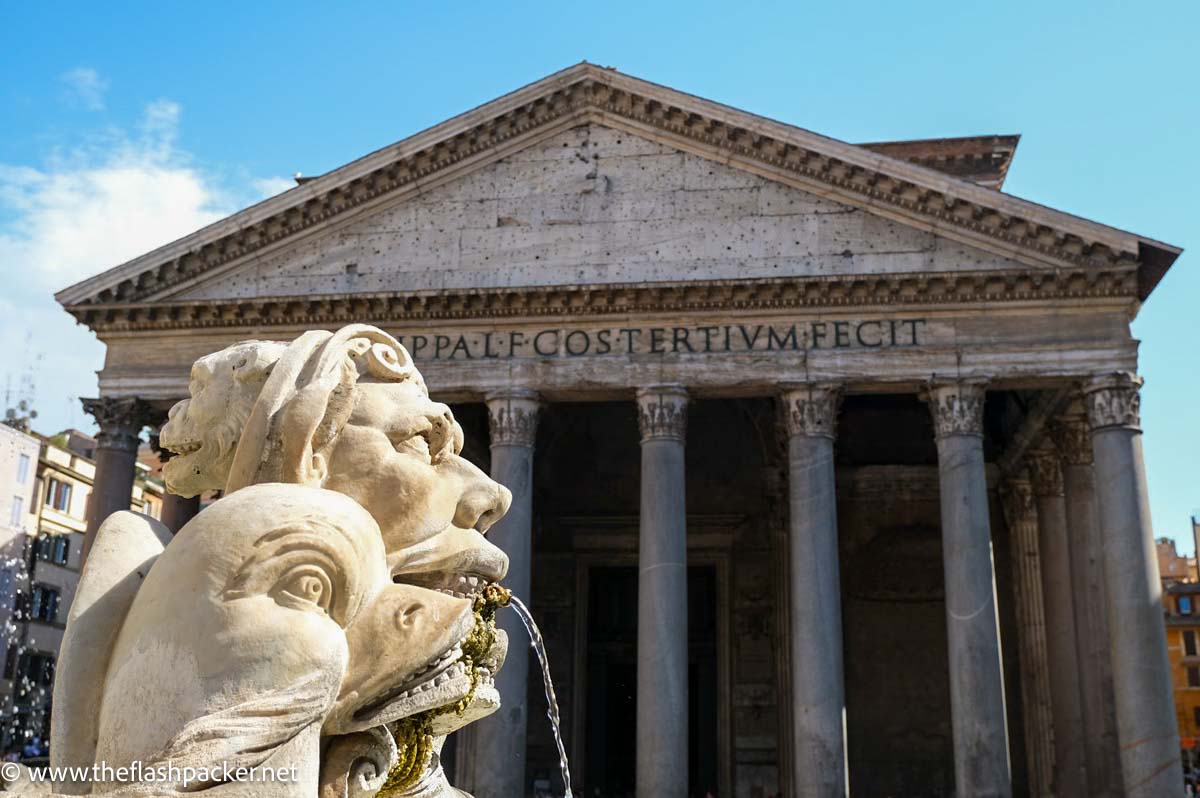
Let me introduce you to my favourite Rome landmark.
The Pantheon has stood as a symbol of the grandeur of Ancient Rome since AD 118-28 when Emperor Hadrian replaced a temple built in 27 BC by Marcus Agrippa, Augustus’s son-in-law. In the year 609 it became the church of Santa Maria ad Martyres and is the final resting place of the great and good of Italy, including the artist Raphael of Urbino and kings Vittorio Emmanuele II and Umberto I.
I visit the Pantheon each time I am in Rome and its simplicity and harmony never fail to fill me with awe. With a diameter of 142 feet, its dome was the world’s largest until 1882 when it was surpassed by one in the English spa town of Buxton.
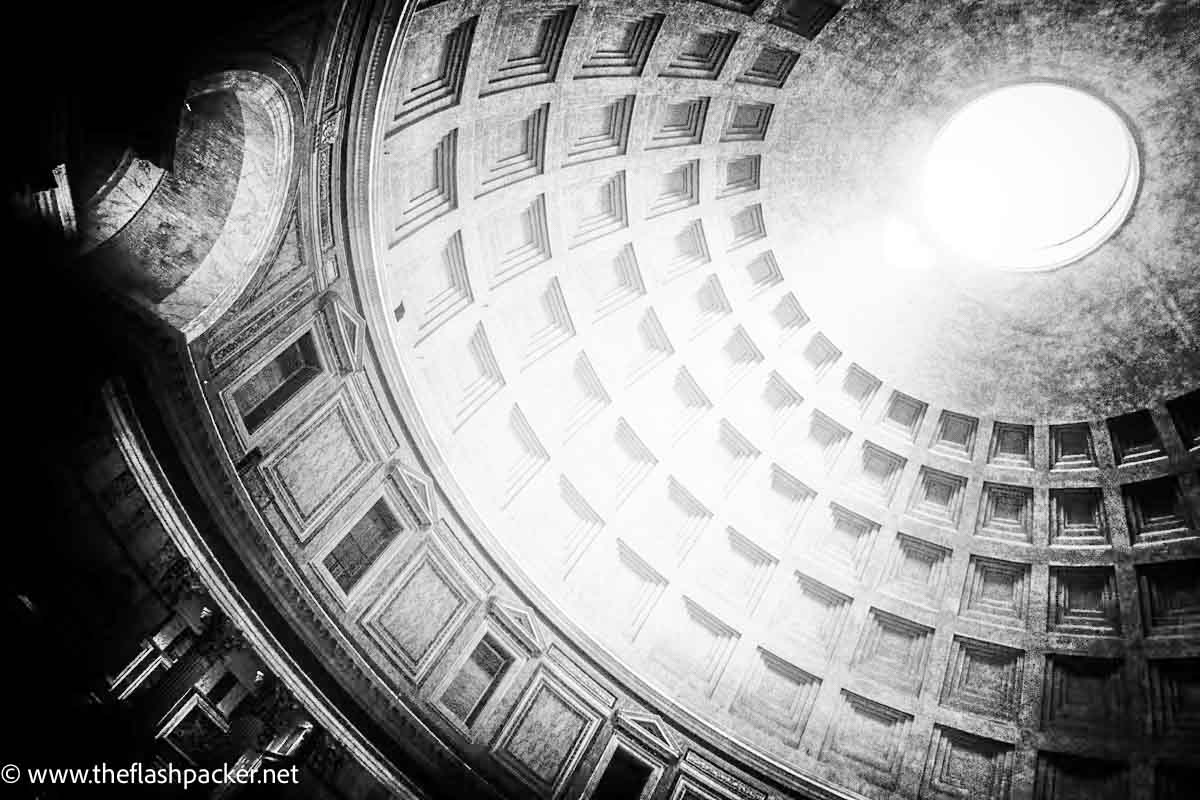
3. St. Peter’s Basilica (Basilica di San Pietro)
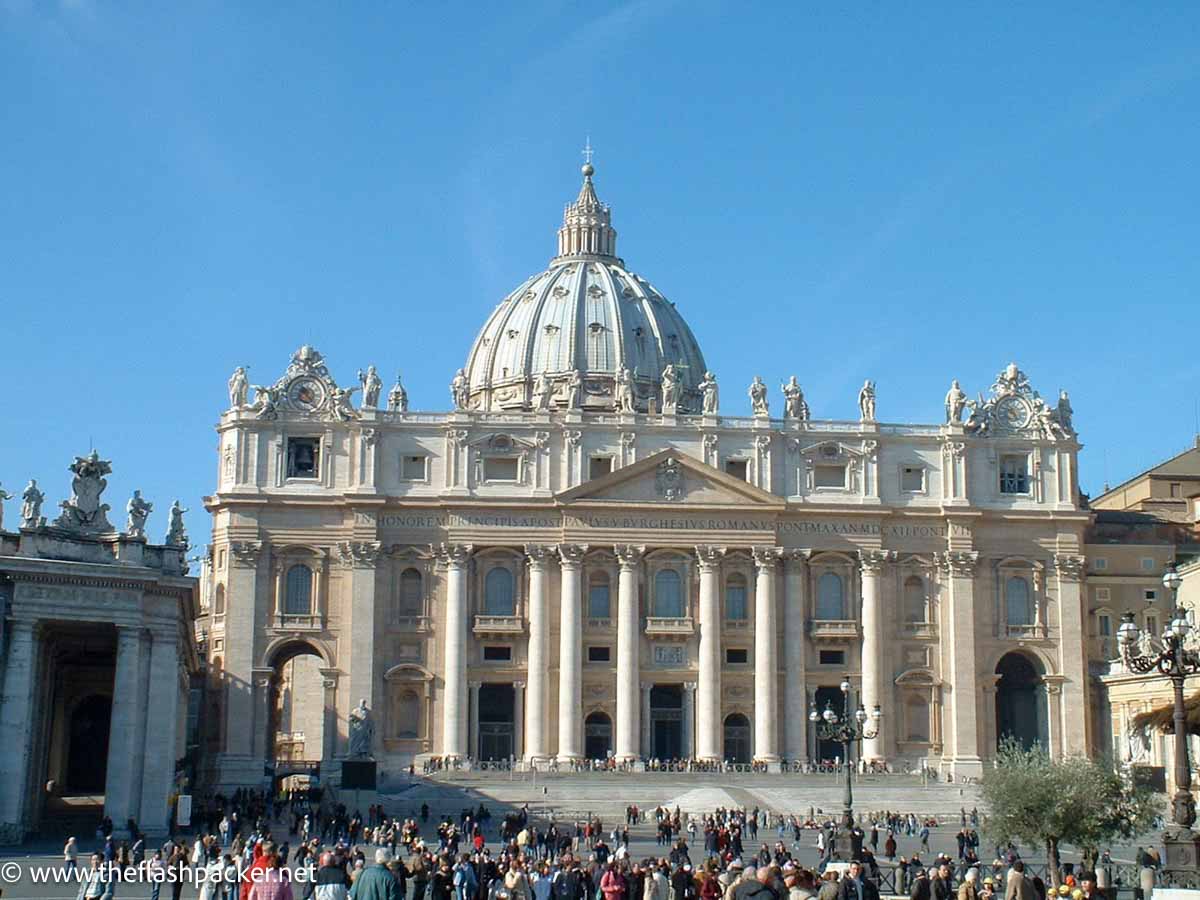
As the spiritual capital of Roman Catholicism, St. Peter’s barely needs an introduction.
The first church was built on this site – reputedly where St. Peter was buried – in 326 AD by Emperor Constantine. It was rebuilt between 1506 and 1626, with Bramante and Michelangelo (among others) having a hand in its design.
This UNESCO World Heritage site is famous for Michelangelo’s dome and his intensely moving Pietà.
4. Trevi Fountain (Fontana di Trevi)
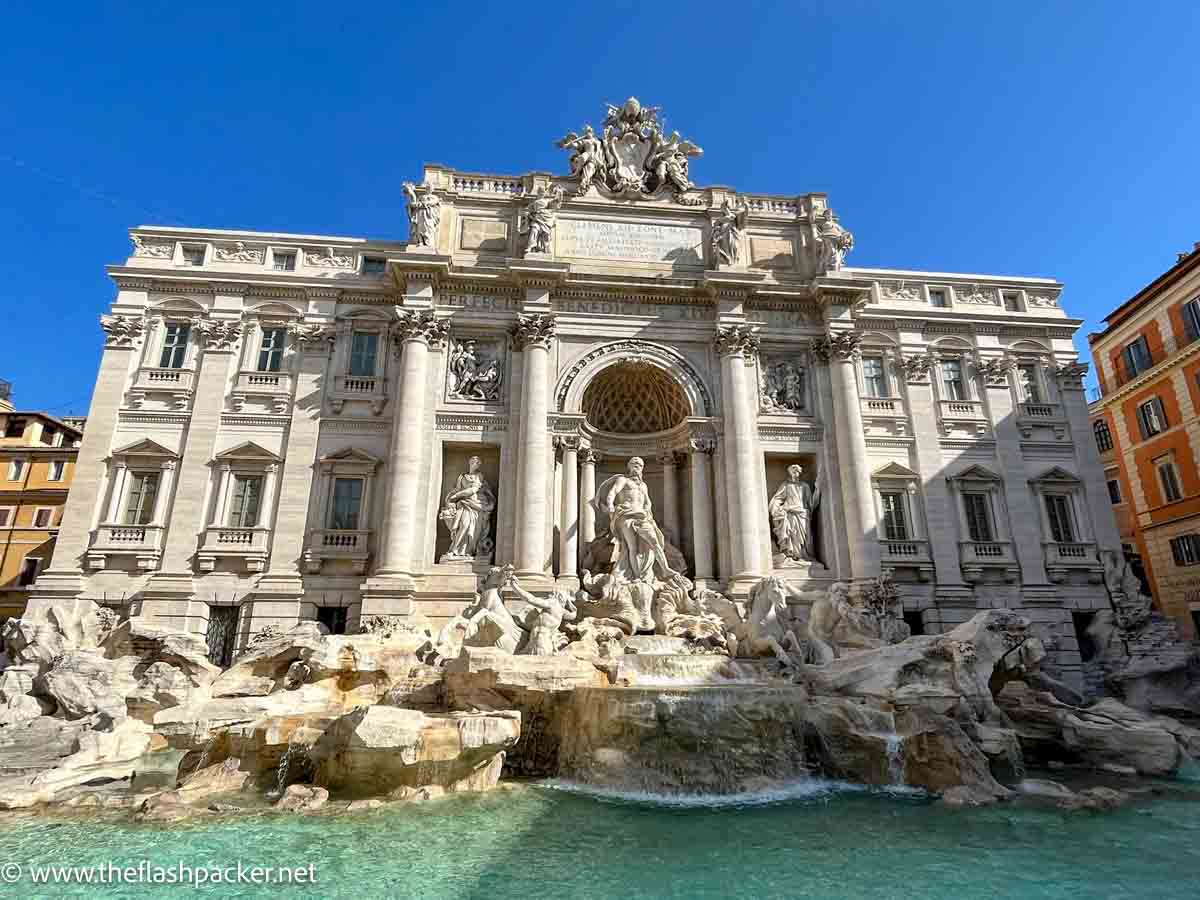
Fontana di Trevi is Rome’s most magnificent fountain, described by Charles Dickens as ‘silvery to the eye and ear.’ This 18th Century monument is made all the more extraordinary by its confined setting, in a small square that is surrounded by a tight warren of streets.
It is fed by the Acqua Vergine Antica, an ancient underground aqueduct that was built by Agrippa to supply public baths near the Pantheon in 19 BC. Its name is thought to have come from tre vie, referring to the three roads that converged at this spot.
Tradition says that if you throw a coin over your shoulder into the fountain this will ensure your return to Rome. All I can say is that it has worked for me.
Like the Colosseum, the Trevi Fountain has been featured in many movies, famously La Dolce Vita (1960) and Roman Holiday (1953).
5. Spanish Steps (Scalinita della Trinità dei Monti)
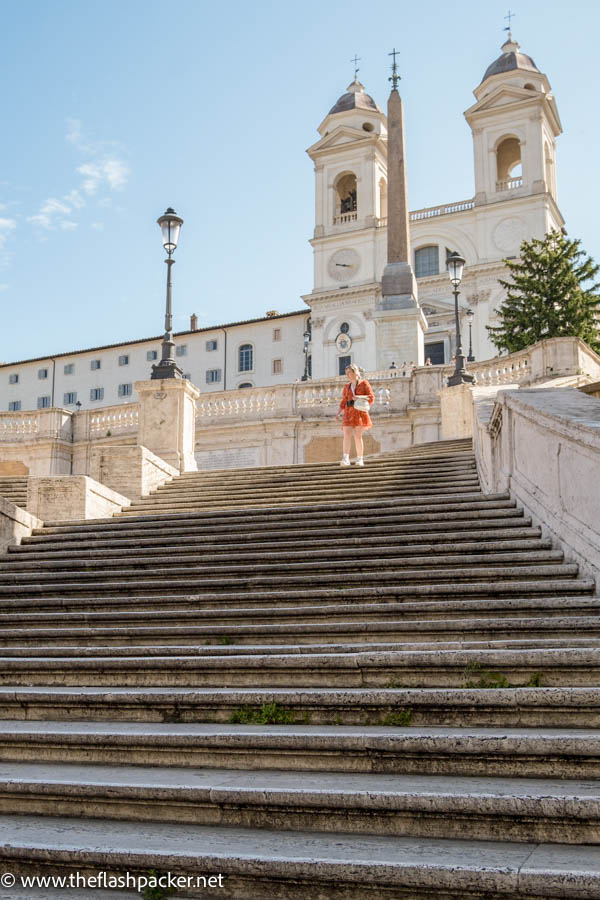
Whilst the Spanish Steps don’t have the wow factor of the Fontana di Trevi, they are nonetheless one of Rome’s most famous sights, largely thanks to their position in the heart of the city’s most upmarket shopping district and their popularity as a meeting place. This monumental flight of 137 steps connects Piazza di Spagna with the church of Trinità dei Monti.
Piazza di Spagna was the focus of Rome’s artistic and literary life for centuries. Keats died in a house on the square and the Brownings had a house nearby.
Take a look at the fountain at the base of the steps. Its design of a half-sunken boat is adapted to low water pressure.
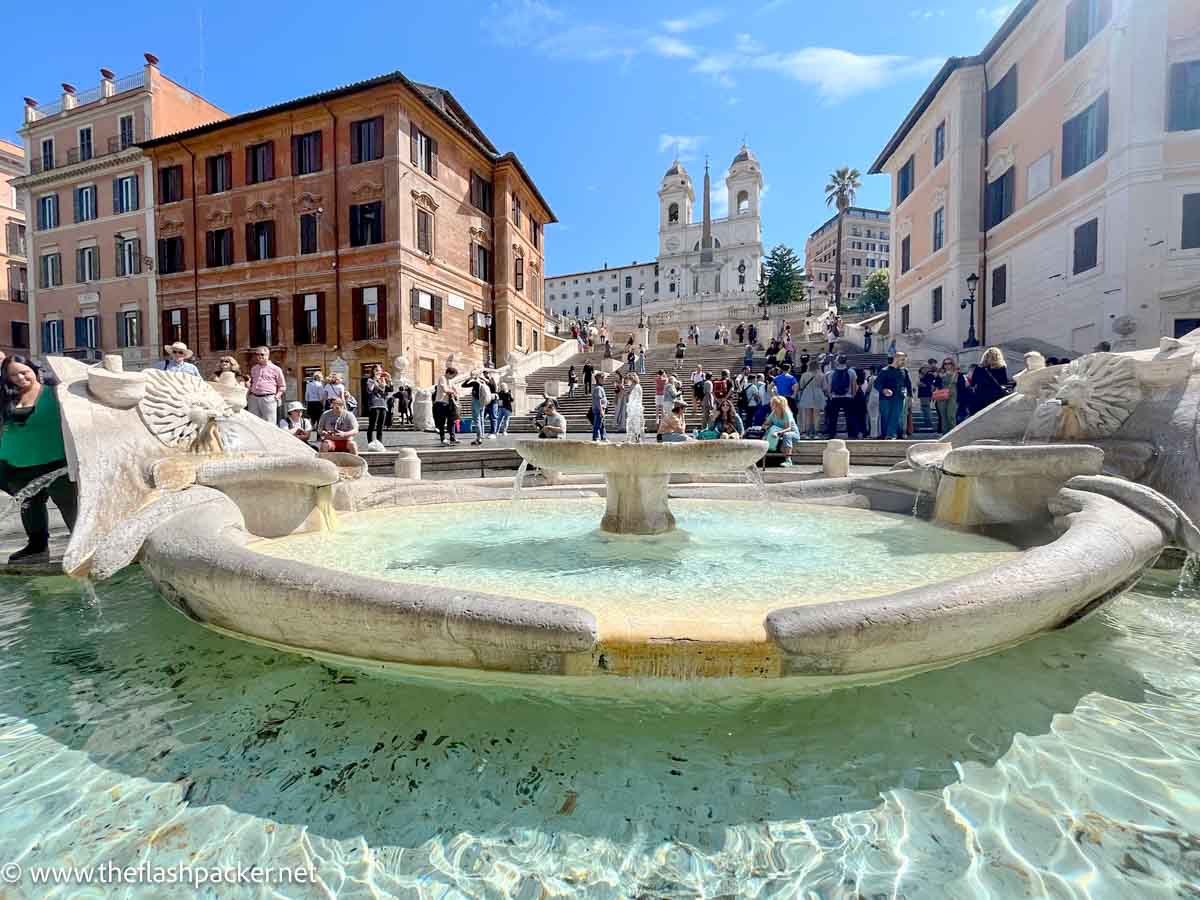
From the top of the steps, there are wonderful views past Palazzo Barberini and towards the Quirinal Hill.
6. Piazza Navona
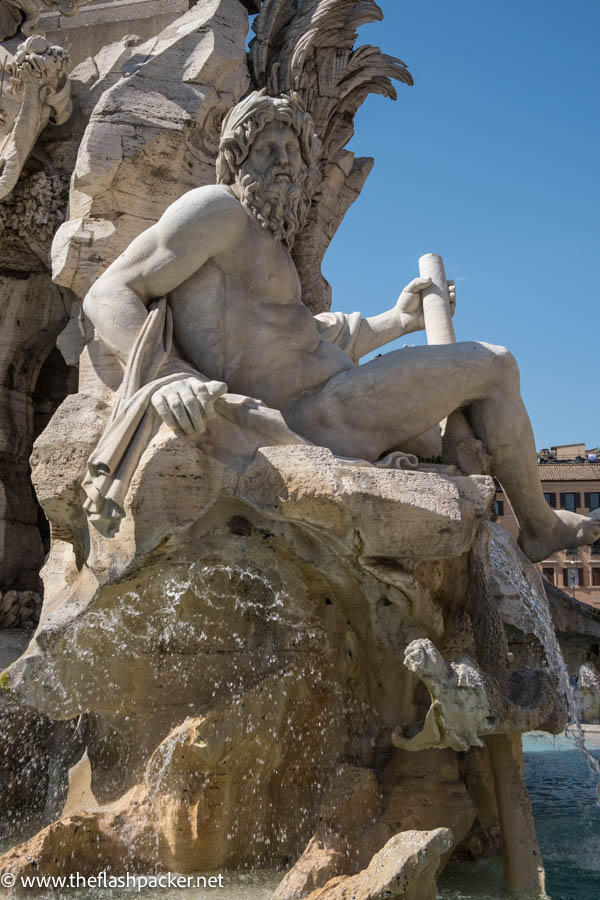
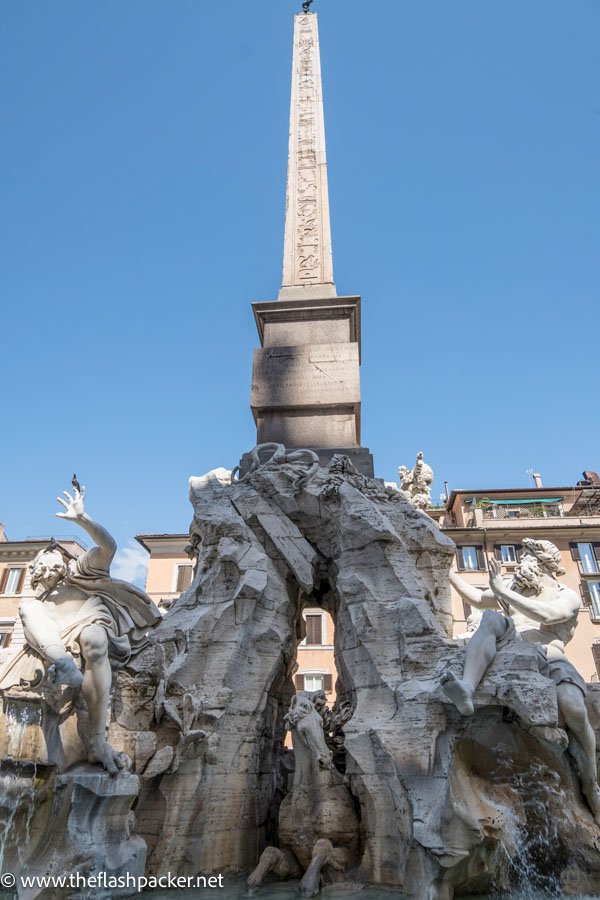
The delightful Piazza Navona is one of the places that best illustrates the spirit of Rome.
A Classical setting– in this case, a Roman circus – has been successfully adapted to the sensibilities of succeeding centuries. The square is a triumph of Bernini’s Baroque style.
Piazza Navona is dominated by the Fontana dei Quattro Fiumi (Fountain of the Four Rivers). Completed in 1651, this is one of Bernini’s most famous works.
The other two fountains in the piazza are Fountain of Neptune and the Moor Fountain.
7. Campo dei Fiori
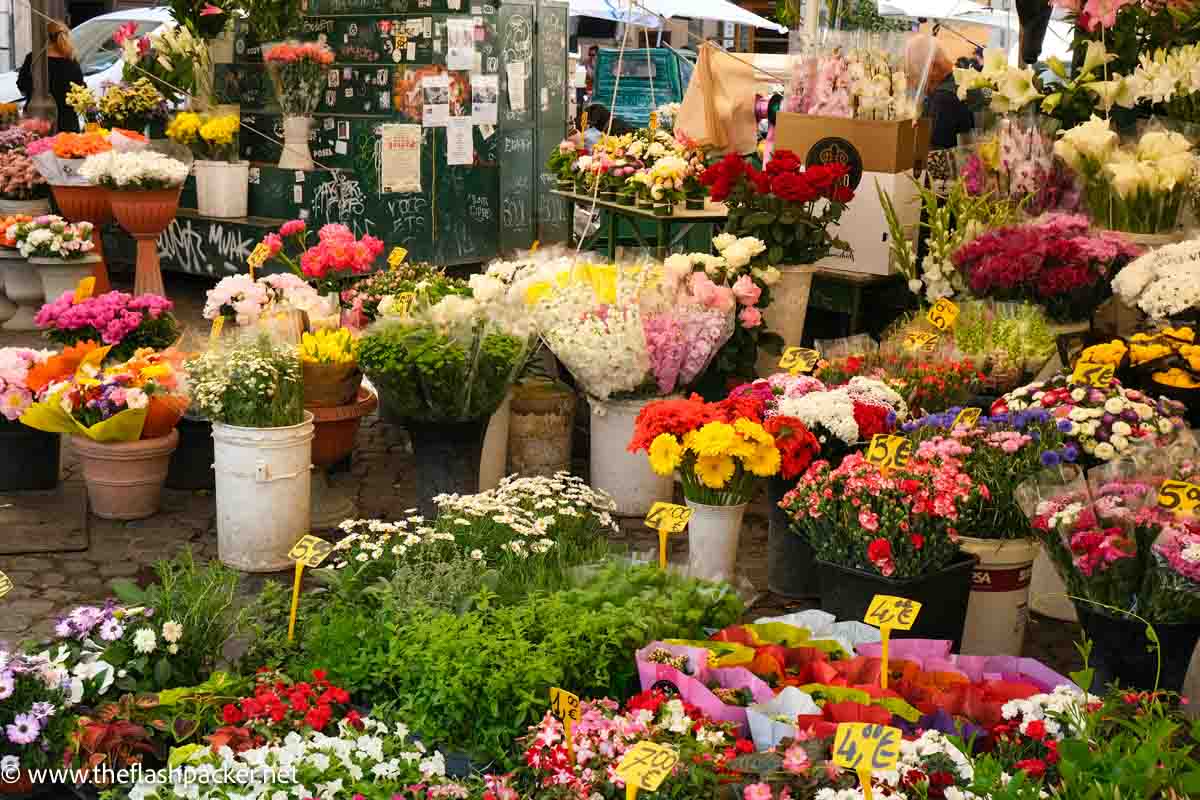
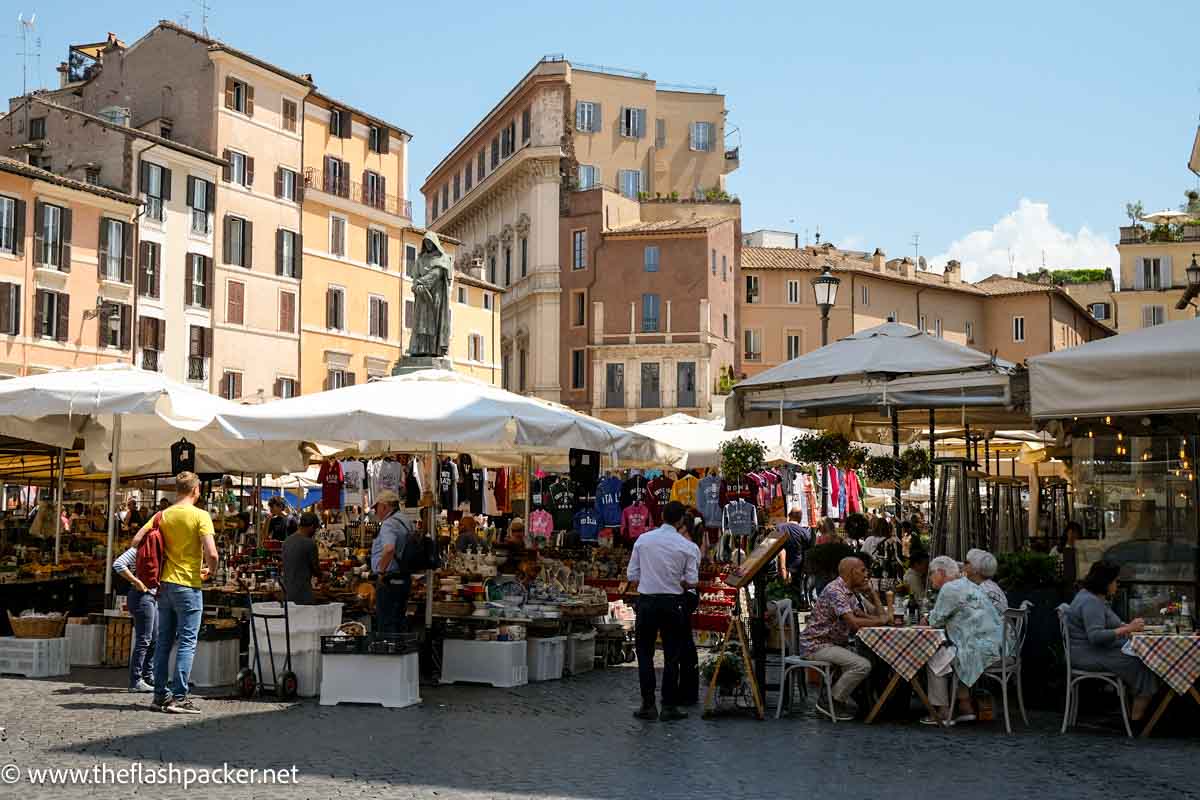
This lively old piazza with its fruit and vegetable market is in one of the most delightful parts of Rome, one that manages to retain a local flavour and that is laced with narrow cobbled streets.
Campo dei Fiori – ‘the field of flowers’ – was once a meadow that became one of the most important piazze in Rome in the 15th Century. Since 1869, it has been a thriving marketplace.
One block south of Campo dei Fiori is the Palazzo Farnese, one of Michelangelo’s Renaissance masterpieces that currently serves as the French Embassy in Rome.
8. Piazza del Popolo
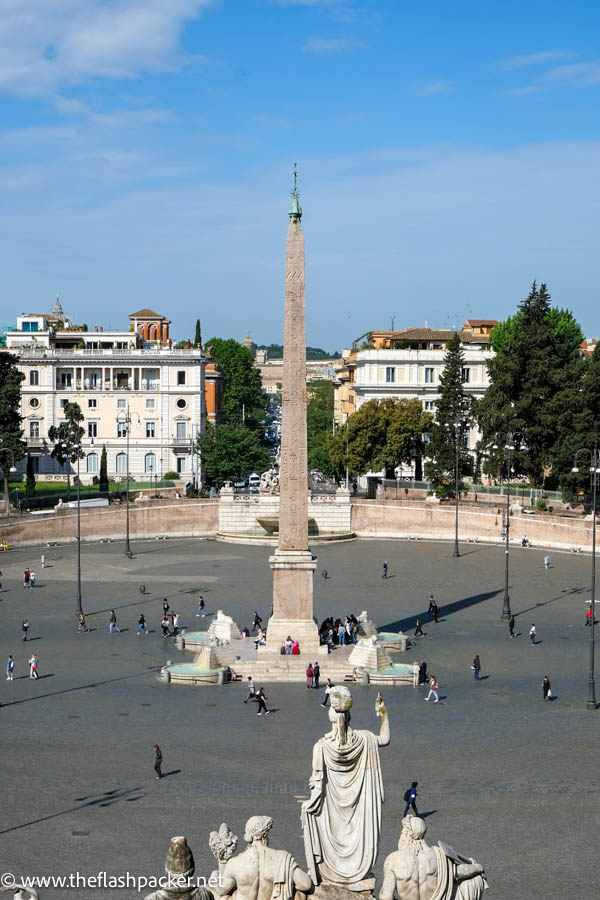
The majestic Piazza del Popolo was designed to provide a scenic entrance to the city from Via Flaminia in the north. Over the centuries, countless travellers would have arrived in Rome through the historic Porta del Popolo.
The piazza was created in 1538 and a 24-meter-high obelisk rises between four charming fountains with lions. Two decorative Baroque churches – Santa Maria del Popolo and Santa Maria in Montesanto – face the square.
From the Pincio Promenade above Piazza del Popolo there are some of the best views of Rome.
9. Castel Sant’Angelo
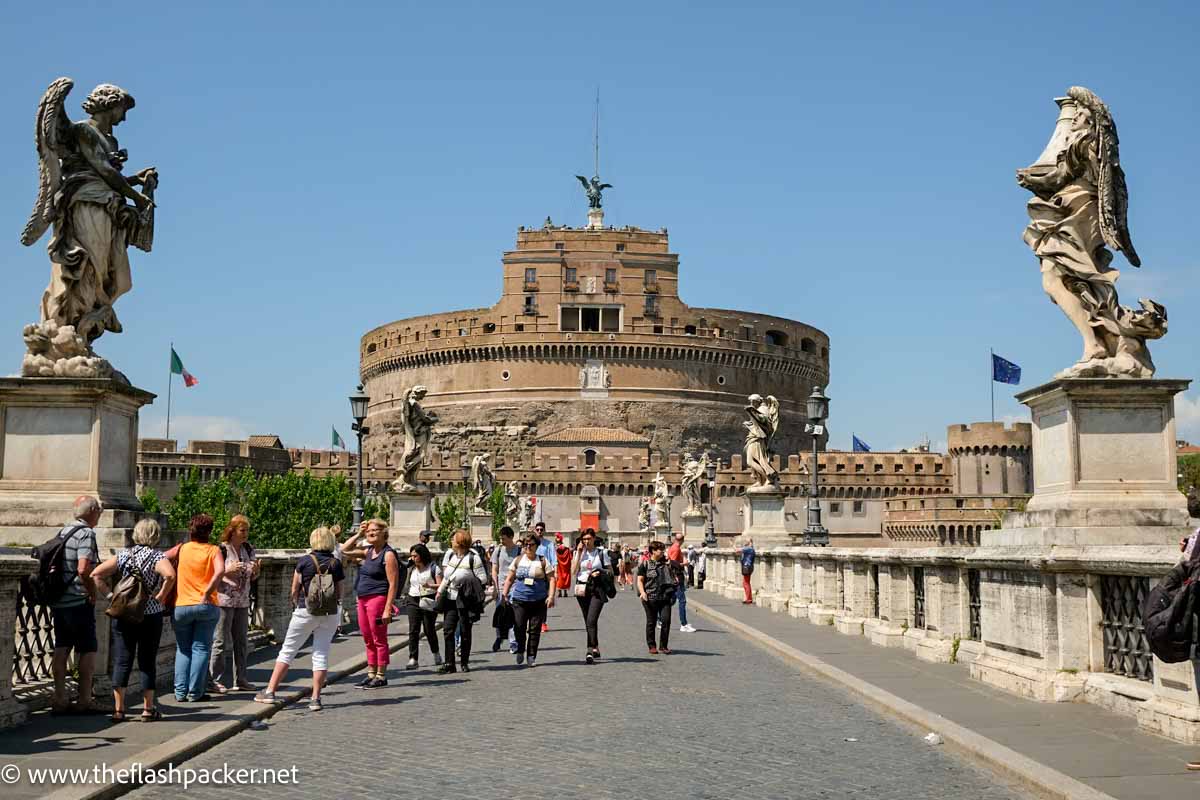
Rising above the River Tiber, Castel Sant’Angelo has served as an imperial tomb, papal fortress, medieval prison and army barracks. This enormous circular structure, which began life as a mausoleum for Hadrian and his family in 130 AD, is now home to a museum.
Access is via Ponte Sant’Angelo, one of Rome’s most beautiful bridges, embellished with ten angels sculpted by Bernini.
10. Vittorio Emanuele II Monument
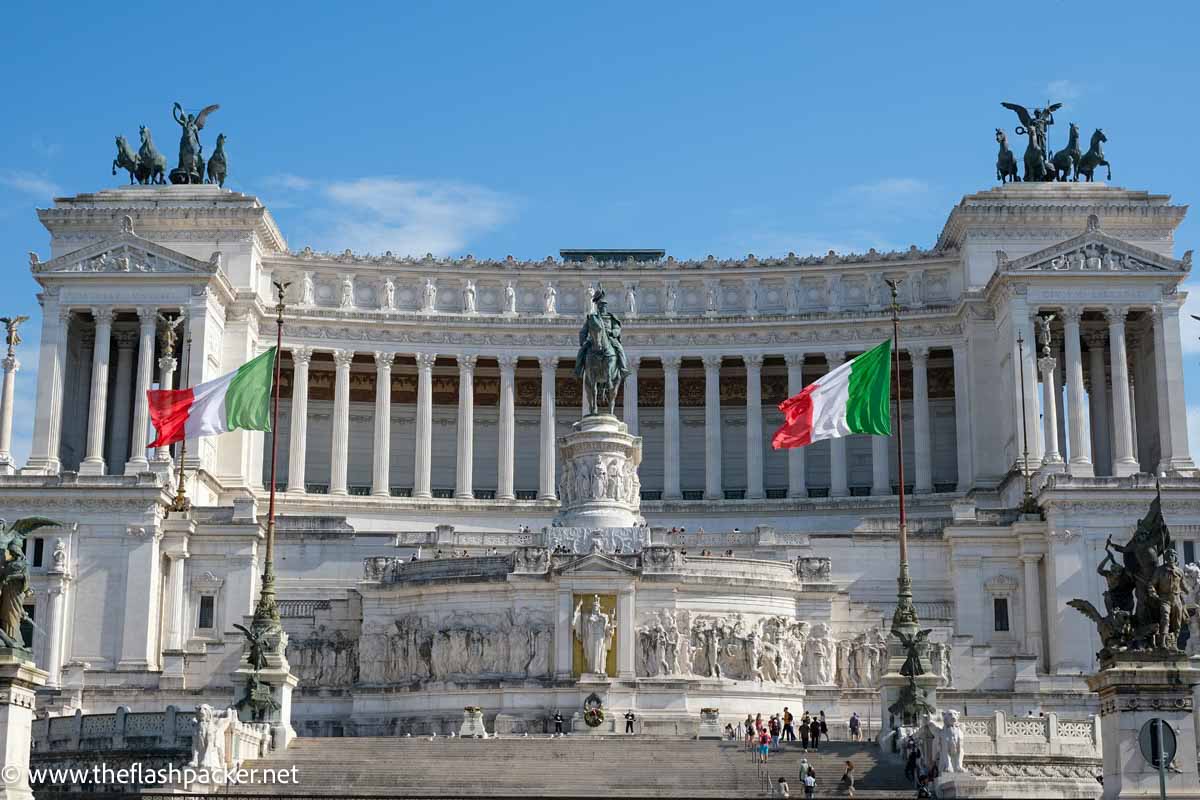
The Vittorio Emanuele II Monument may be the Marmite of Rome’s monuments.
Also called the Altar of the Fatherland or Vittoriano, this Neo-Classical structure was built between 1885 and 1927 by the artist Sacconi to symbolise Italian unity. It is also called ‘the wedding cake’ or ‘Mussolini’s typewriter’.
To me, it’s a monstrosity but a famous monstrosity nonetheless.
Monuments and Ruins of Ancient Rome
Echoes of its ancient history are inescapable when you visit Rome. For more than 1,000 years the Roman Empire conquered most of Europe, much of western Asia, northern Africa and the Mediterranean islands. It became a byword for civilization.
Some of these vestiges of the city’s past are hulking ruins; others provide a tantalising window into Rome’s tumultuous history. But, with a little imagination, they can bring to life the triumphs and tribulations of Ancient Rome.
11. Roman Forum (Foro Romano)
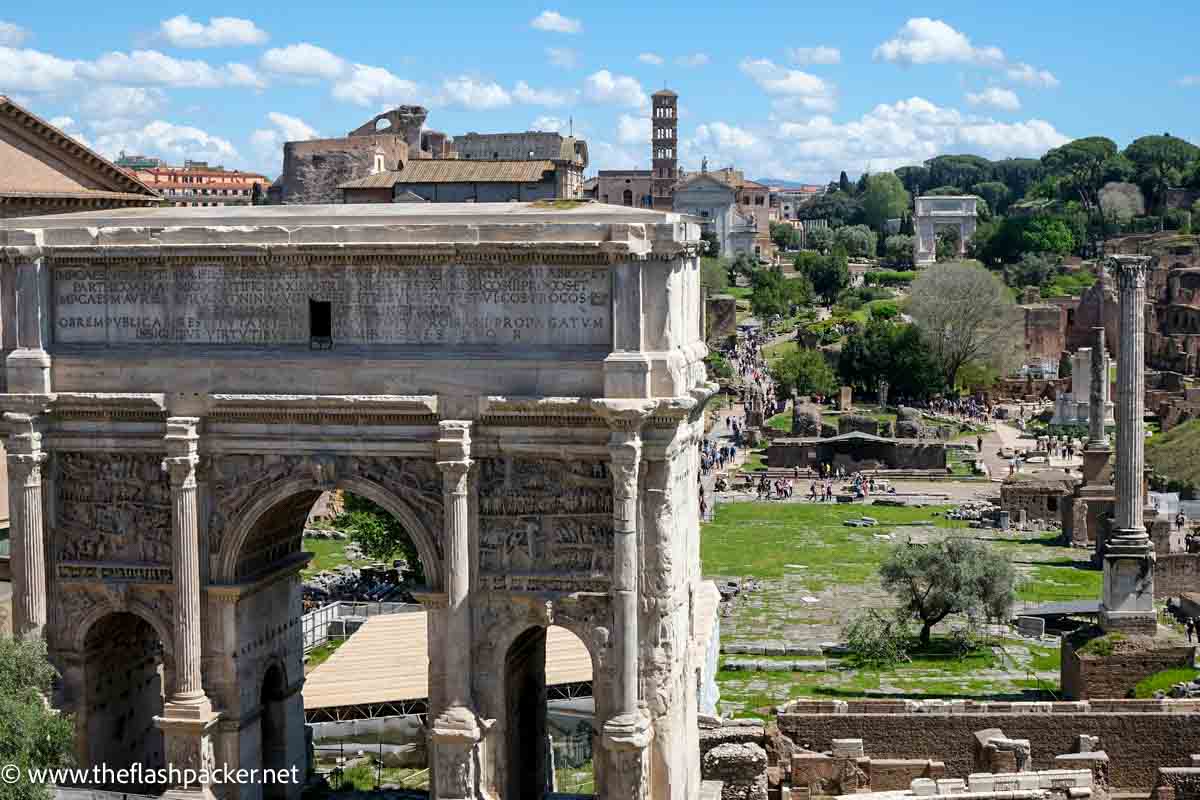
The Roman Forum was the civic and political heart of the Roman Empire and is one of the most evocative places in Rome. Its fragments and stones stand as a romantic testament to this once-powerful state.
Foro Romano started life as a marshy valley between the Capitoline and Palatine hills, later acquiring the structures of Rome’s burgeoning civic, social and political life.
Two millennia of decay and looting have left a mish-mash of pillars and stones. But armed with a guide and a little imagination, you can make sense of what the Forum would have been like in its glory days.
12. Arch of Constantine (Arco di Constantino)
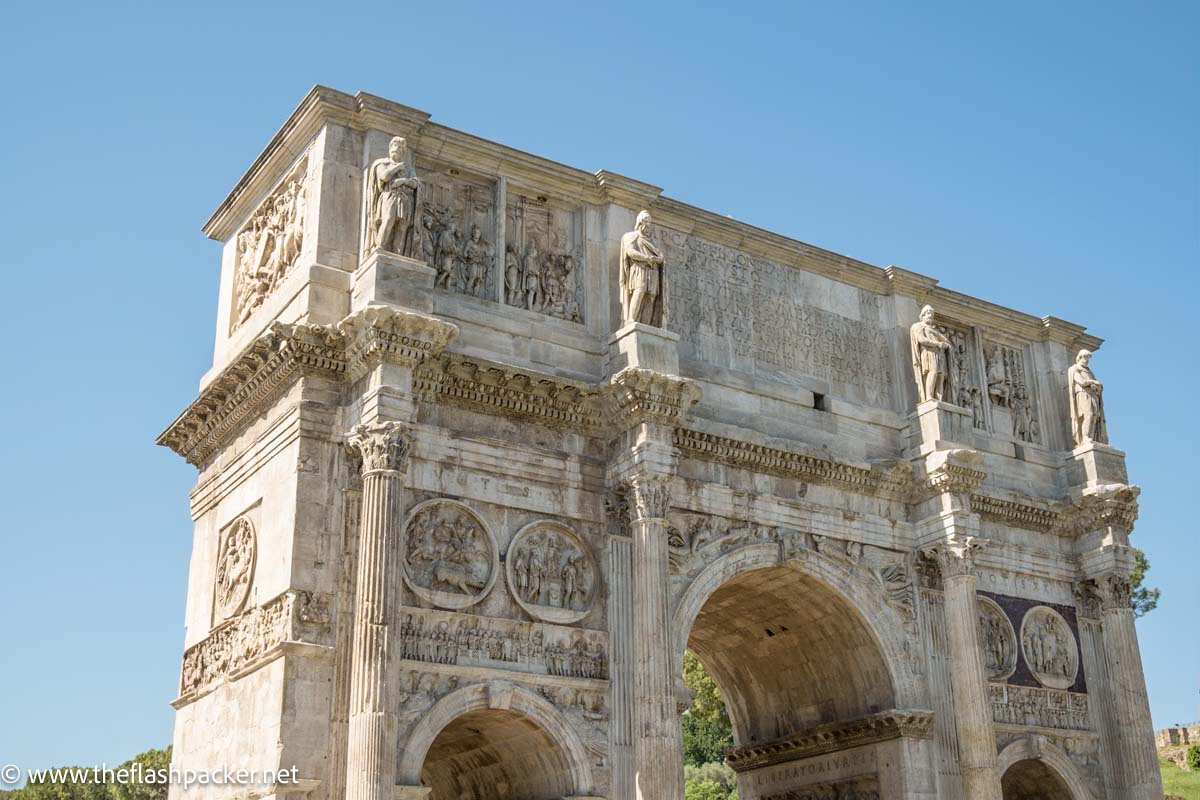
Triumphal arches were not uncommon in the Roman Empire and this one was erected to celebrate the victory of Emperor Constantine over his imperial rival Maxentis in 312 AD.
The Arch of Constantine is one of the last great monuments to be built in Ancient Rome. Standing 69-foot-high and 85-foot wide it is also one of the largest of Rome’s arches and one of its best preserved.
13. Trajan’s Forum & Markets
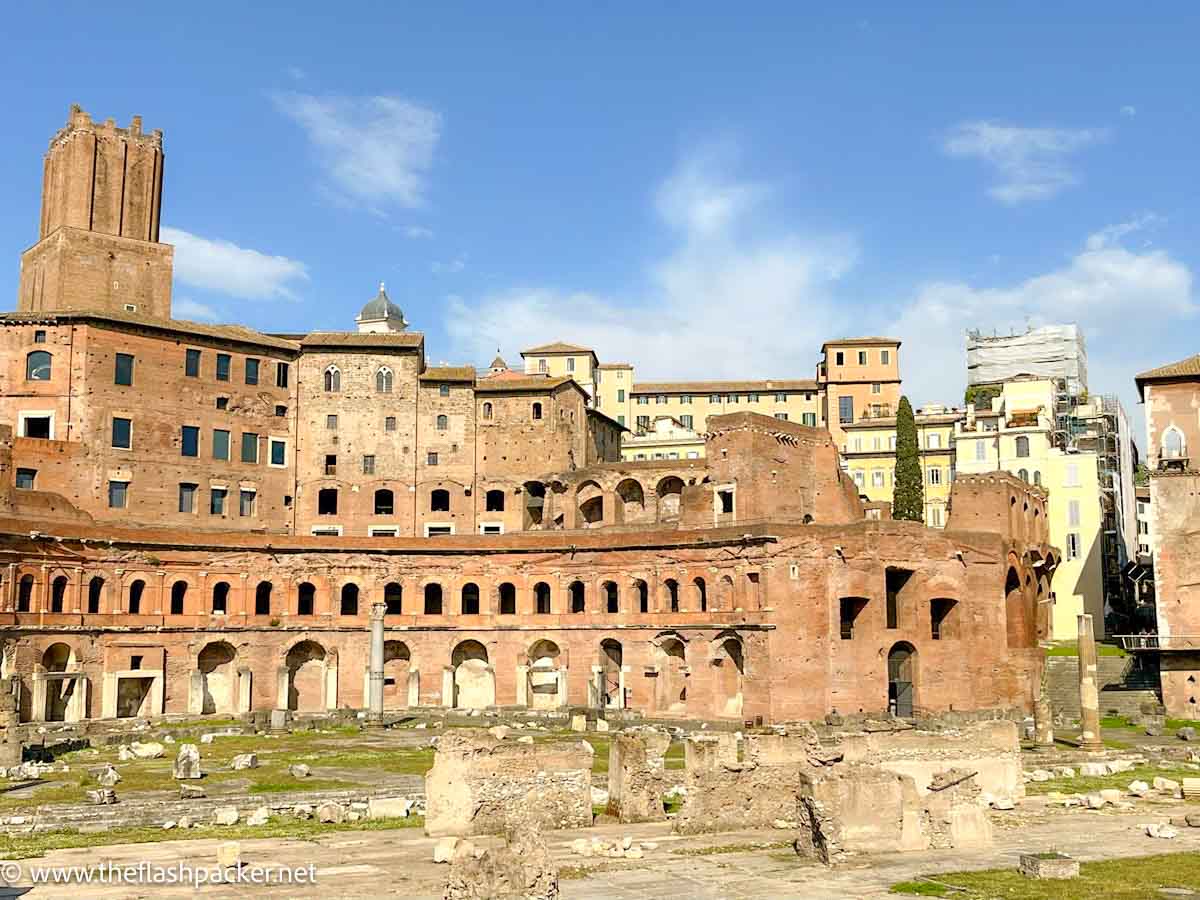
The Forum of Trajan is one of the Imperial Fora, which were laid out by Julius Caesar and then by emperors Augustus, Vespasian, Nerva and Trajan as an extension to the Roman Forum. It was built between 107 and 113 AD to celebrate Trajan’s military victories.
The Markets of Trajan, a semi-circular complex of more than 150 shops, can be thought of as one of the first covered shopping malls. They were built at the beginning of the 2nd Century AD.
14. Largo di Torre Argentina
Largo di Torre Argentina is one of Rome’s most historic squares.
Located in the heart of the city, between the Ghetto and the Pantheon, this is home to four Roman temples and Rome’s cat sanctuary (Il Santuario dei Gatti di Torre Argentina).
But Largo di Torre Argentina is most famous as where Julius Caesar met his fate. On the Ides of March of 44 BC, he strode into the Senate and was stabbed 23 times by 23 conspirators.
This archaeological area is open to the public. Non-residents will pay a small charge to visit.
15. Circus Maximus (Circo Massimo)
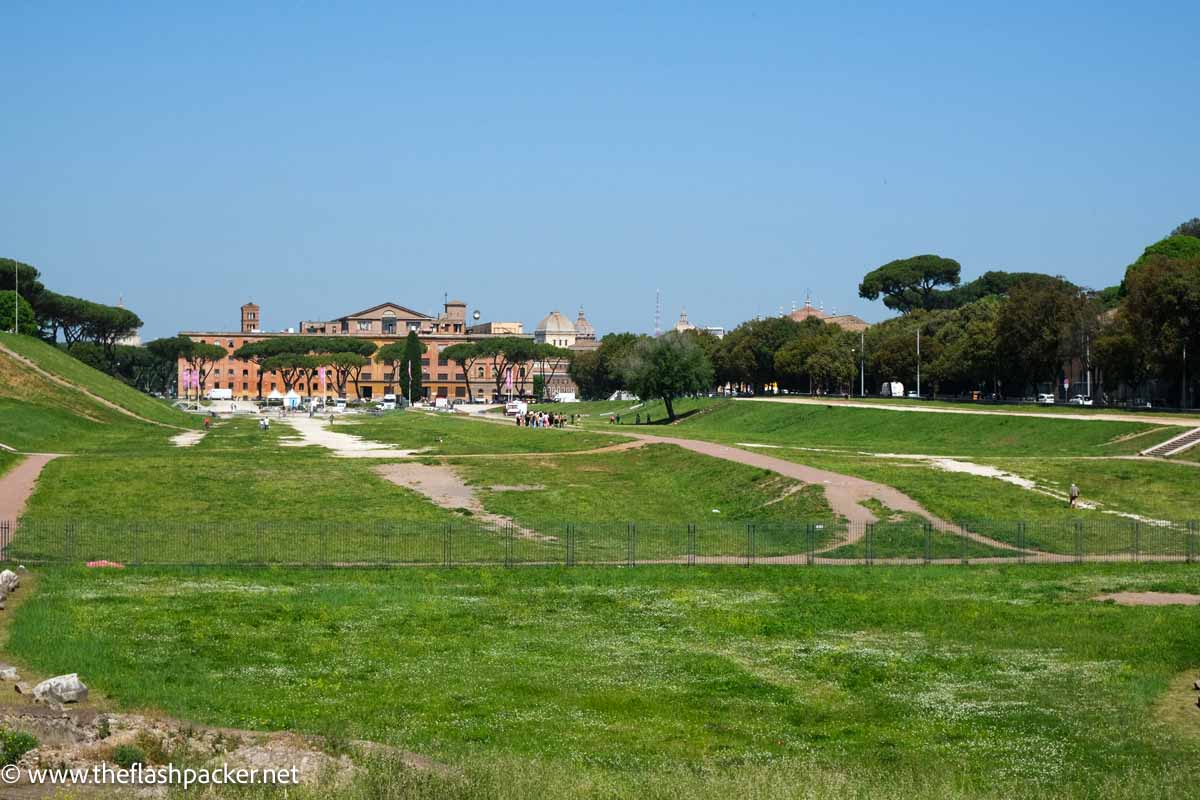
It takes a little imagination to picture today’s Circus Maximus as it would have been back in the days of the Roman Empire.
Only the shape of this enormous grassy area survives, but this is where up to 300,000 Romans would have come to see chariot racing. Dating from 329 BC, it set the mould for subsequent racecourses.
Today, Circo Massimo is a public park from where there is a fine view of the buildings of the Palatine Hill.
16. Baths of Caracalla (Terme di Caracalla)
The Baths of Caracalla were the most luxurious baths in Ancient Rome and one of the largest, accommodating as many as 1,600 bathers at a time. They were started by Septimus Severus in 206 AD and completed by his son, Caracalla, 11 years later.
These vast sun-baked ruins are not only architectural masterpieces but are also incredibly evocative.
17. Via Appia Antica and the catacombs
Once an imperial highway, Via Appia Antica is lined with ancient monuments, tombs and catacombs. It was built by Appius Claudius Caecus in 312 BC to link Rome with Capua, a city 14 miles north of Naples.
The catacombs were used by early Christians as underground cemeteries outside the city walls. They are fascinating to visit, although they can be busy.
The two most important catacombs along the Appian Way are the Catacombs of San Sebastiano and the Catacombs of San Callisto. You can only visit these catacombs on a guided tour.
18. Ara Pacis
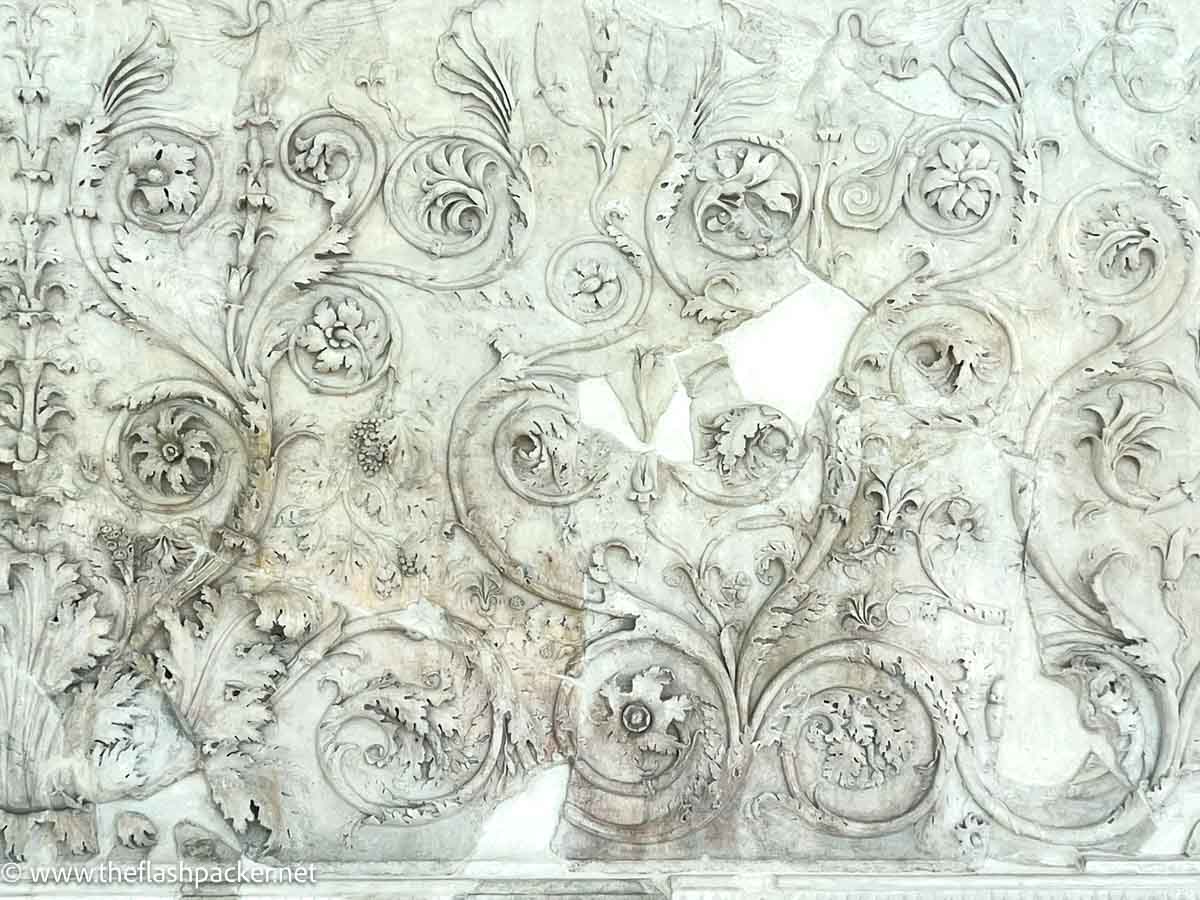
Ara Pacis is one of Rome’s less well-known gems but one of the most important monuments of Ancient Rome.
Housed in a modern museum designed by Richard Meier, Ara Pacis is a monumental marble altar featuring wonderful carved decorations. It was consecrated in 13 BC and was dedicated to the peace and stability that Augustus had brought to the Empire.
You need to pay to visit the museum (Ara Pacis is the only thing that it houses). But you can take a look at it for free through the window.
19. Ostia Antica
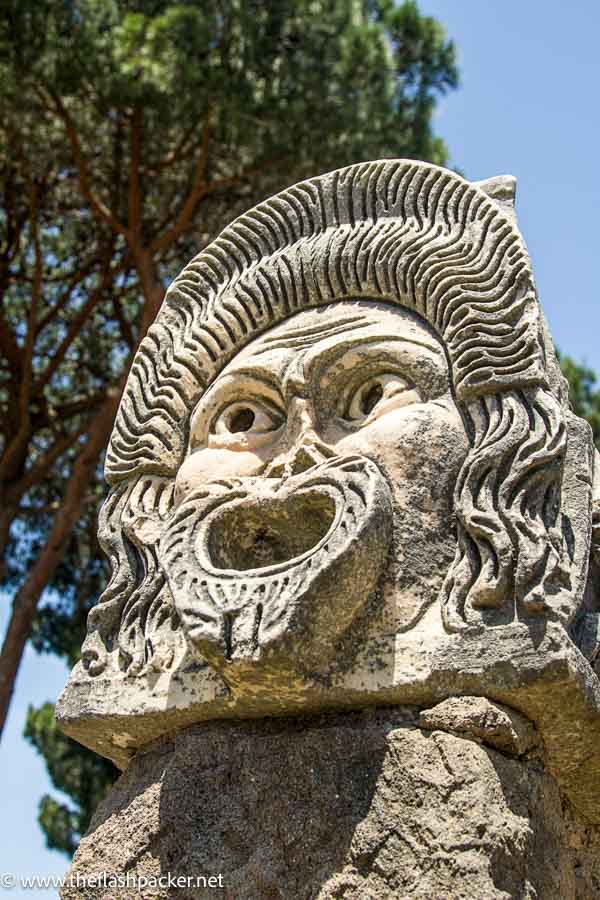
You will need to take a train to see the last of my Ancient Rome landmarks. But trust me; it’s worth it.
Located 15 miles southwest of Rome, along with Pompeii and Herculaneum near Naples, Ostia Antica is one of Italy’s best-preserved Roman towns. Built at the mouth of the Tiber as the seaport for Ancient Rome, it thrived as a colony before the joint efforts of loss of trade, increased prevalence of malaria and the decline of the Empire hastened its demise.
Among its many highlights are several multi-storey apartment blocks known as insulae, countless warehouses, mosaics and a 4,000-seat amphitheatre.
Famous Museums
One thing that Rome is not short of is museums and galleries. But which are those that are most worthy of your precious time?
Here is my pick of the best.
20. Vatican Museums (Musei Vaticani)
The Vatican Museums are not only the most famous in Rome but are also the world’s largest museum complex. Their 1,400 rooms are brimming with artistic treasures, from Classical sculptures to Renaissance gems.
Follow the mandatory one-way route to the museums’ highlights: the Sistine Chapel and the Stanze di Raffaello.
The Sistine Chapel is one of the most magnificently decorated spaces in the world and the largest concentration of Renaissance wall paintings executed in pure fresco. Michelangelo’s ceiling, and especially The Last Judgement, is one of the greatest works in the history of art.
Raphael was commissioned to paint four rooms in 1508 and the Stanze are considered to be his masterpiece.
21. Capitoline Museums (Musei Capitolini)
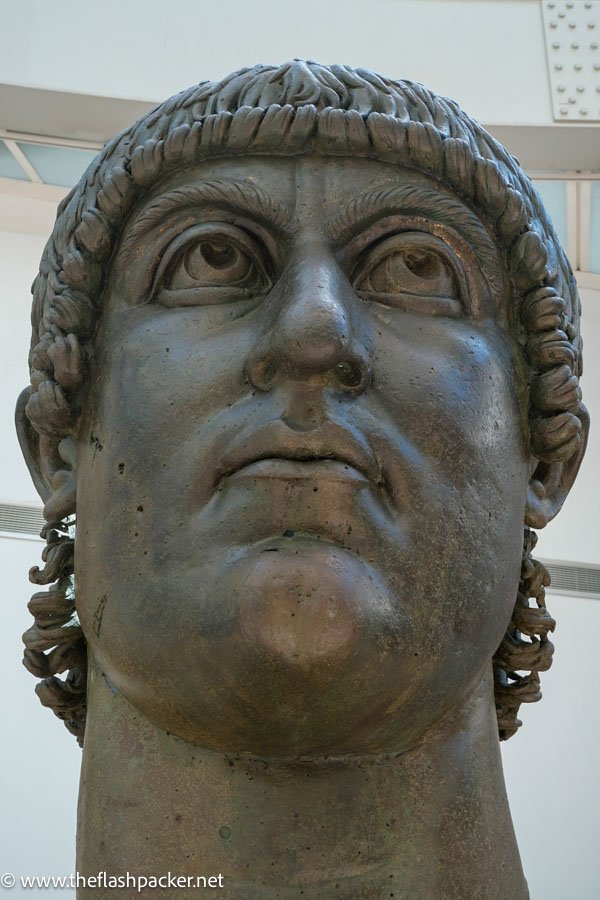
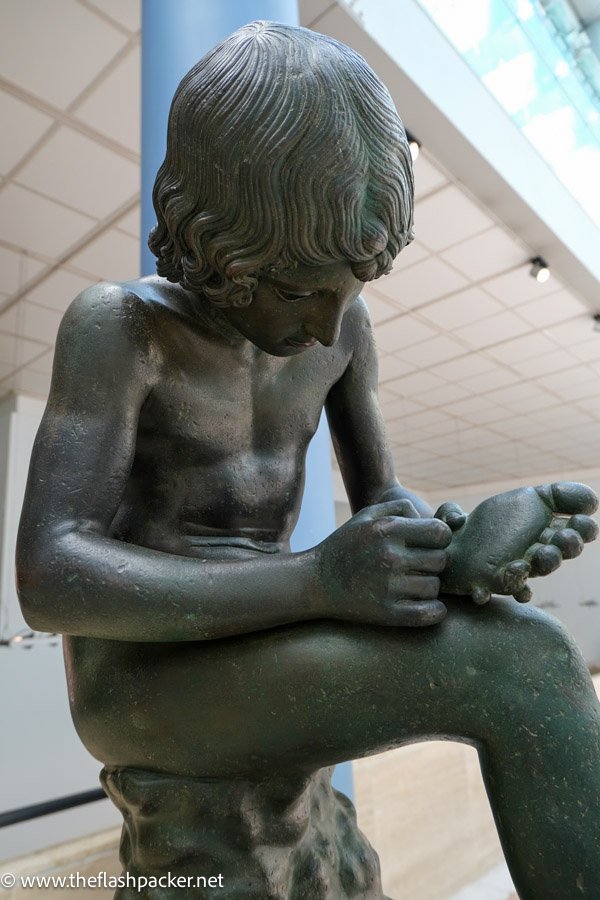
The Capitoline Museums are to sculptures in Rome what the Bargello is to sculptures in Florence. Whilst they are few in number, their artworks are outstanding and are a far more accessible introduction to Classical sculpture than the Vatican Museums.
Comprising Palazzo Nuovo and Palazzo di Conservatori, they are a treasure trove of artistic gems, including the famous Spinario and the She-Wolf of Rome.
22. Galleria Borghese
Housed in the Villa Borghese, the 17th Century summer retreat for Cardinal Scipione Borghese, the small but perfectly formed Galleria Borghese has a wonderful collection of paintings and sculptures. This includes masterpieces by Bernini, Raphael, Titian and Caravaggio amongst others.
This is one museum in Rome where you are obliged to book your ticket in advance.
23. Doria Pamphilj Gallery (Palazzo-Galleria Doria Pamphilj)
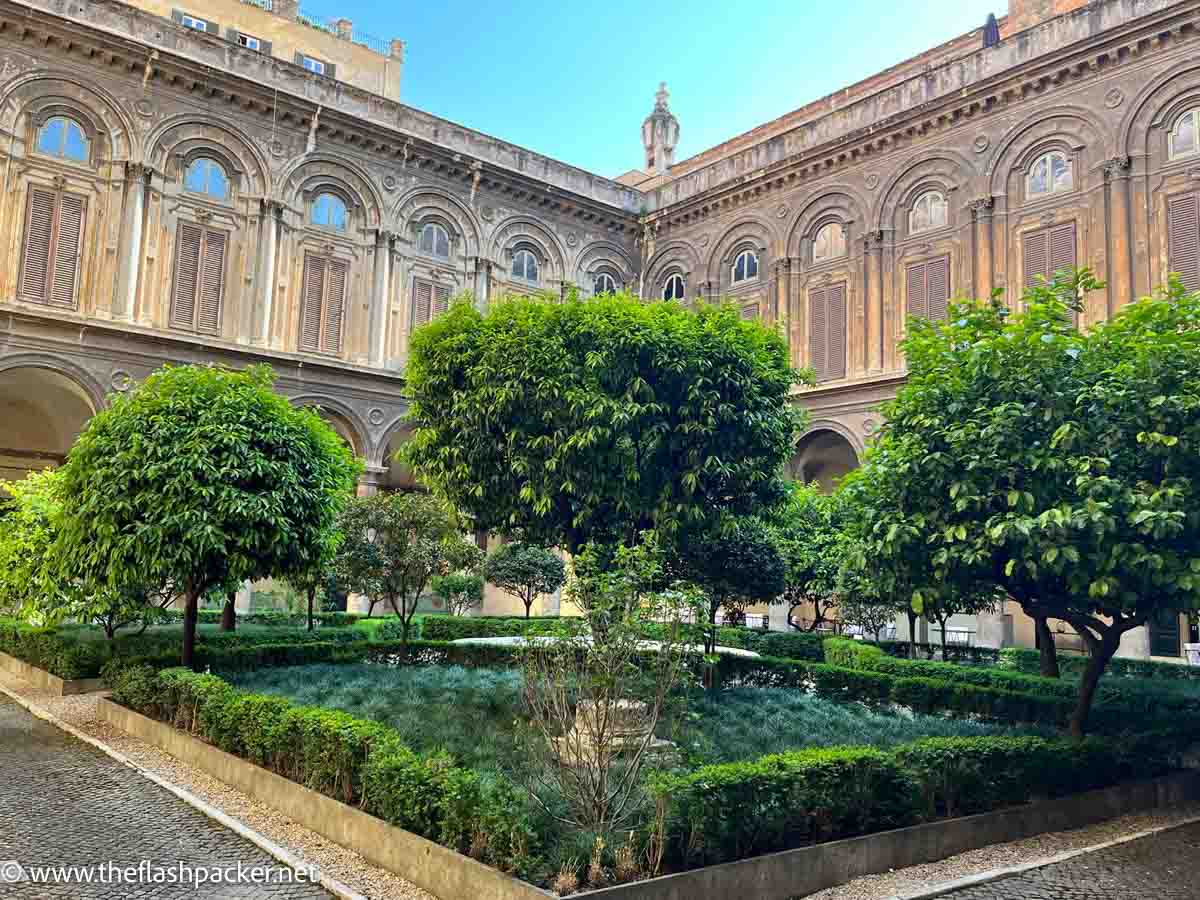
Don’t be fooled by the bland exterior of the Palazzo Doria Pamphilj. The sumptuous interior of this palace, one of Rome’s largest, is worth the ticket price alone.
Located a few meters from Piazza Venezia, this huge palazzo has been the residence of the Doria Pamphilj, a famous Roman noble family since the 17th Century. It is home to the Galleria Doria Pamphilj, one of the most important patrician art collections in the city.
Famous Churches and Other Places of Worship
Rome has more than 900 churches and many of these places of worship are the legacy of the architectural and artistic development of the city over the centuries. Let’s take a look at some of the most famous and remarkable of these.
24. Santa Maria Maggiore
Thanks to its magnificent mosaic-clad interior, Santa Maria Maggiore is Rome’s finest Early Christian basilica. Mass has been celebrated here every day since the 5th Century.
It has the highest campanile in Rome and its coffered ceiling was reputedly gilded with the first gold to arrive from the New World. But its main treasures are the 36 mosaics in the naves, on the triumphal arch and in the basilica’s apse.
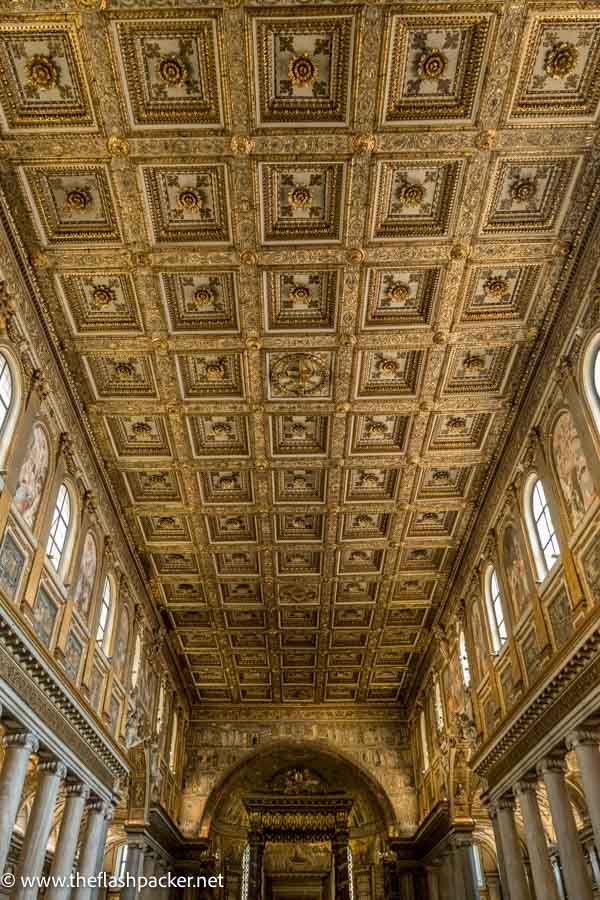
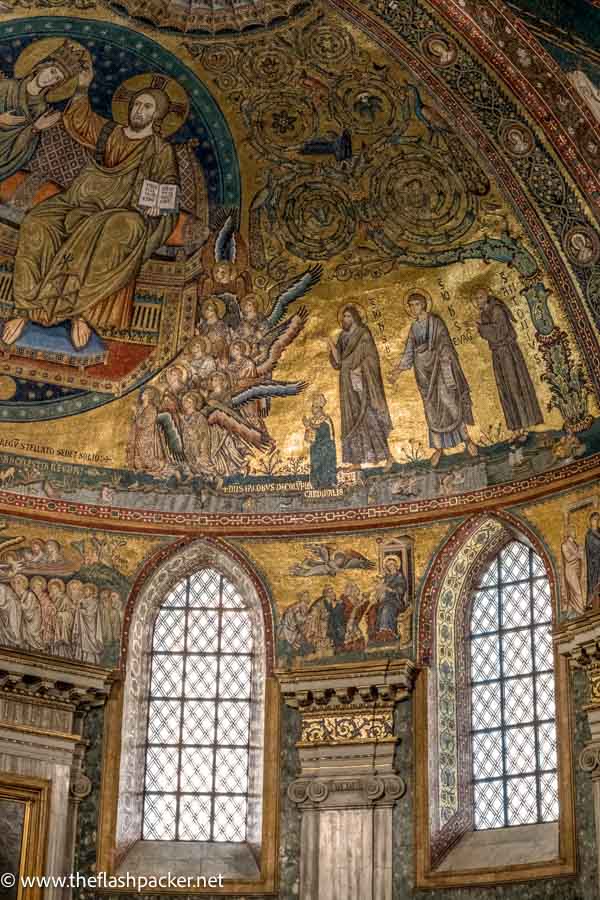
25. St. John Lateran (San Giovanni in Laterano)
With its distinctive statues rising over the rooftops, San Giovanni is a Rome landmark in more than one sense of the word. Its soaring façade reminds us that this is the cathedral church of Rome.
Dating from the early 4th Century, San Giovanni in Laterano was the first Christian basilica to be built in Rome. An ornate ceiling tops off its cavernous interior and there is a beautiful cloister off the north transept.
26. San Pietro in Vincoli
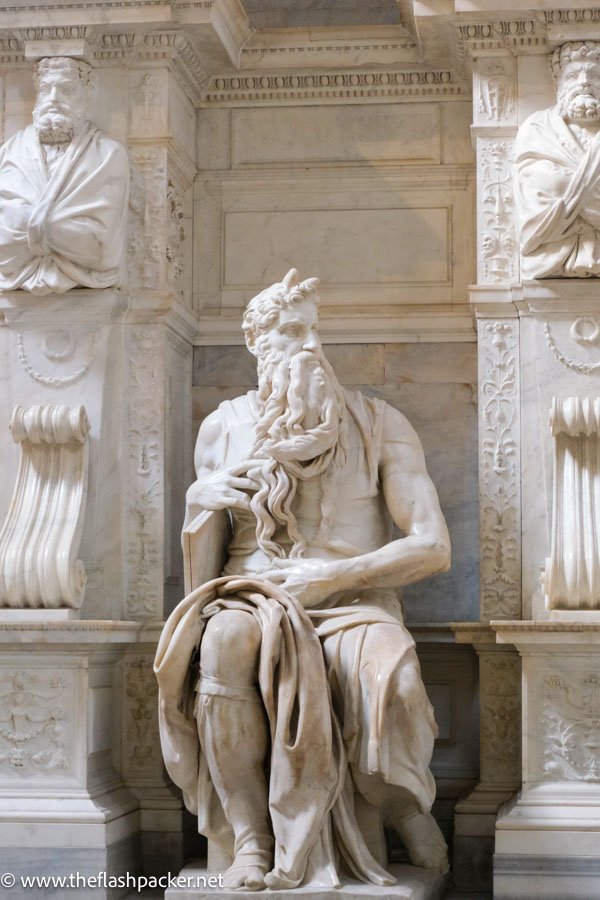
Stop by the charming San Pietro in Vincoli for Michelangelo’s majestic sculpture of Moses, designed for the tomb of Pope Julius II. The artist spent years scouring the Carrara mines for suitable pieces of marble for this project that was subsequently abandoned.
If you are visiting Florence, you can see the unfinished Slaves statues that were intended for this tomb.
The church gets its name from the chains (vincoli) that were said to have bound St. Peter when he was held in the Mamertine prison. These chains are displayed in the coffer with bronze doors beneath the high altar.
27. San Clemente
No other landmark in Rome reveals the layers of history that underpin this city as well as San Clemente.
The Basilica of San Clemente, comprises two superimposed churches.
Dating from 1108, the upper church is a typical basilica and has been almost untouched since the 12th Century. Descend to the lower church and continue downwards to the best preserved of 12 Mithraic temples in Rome. Mithraism was a popular pre-Christian pagan cult for men only.
28. Santa Maria de Popolo
Enter the peaceful Santa Maria de Popolo to see works of art from all periods, including masterpieces by Caravaggio and Raphael. In some of the chapels and in the apse there are push-button lights for a small fee.
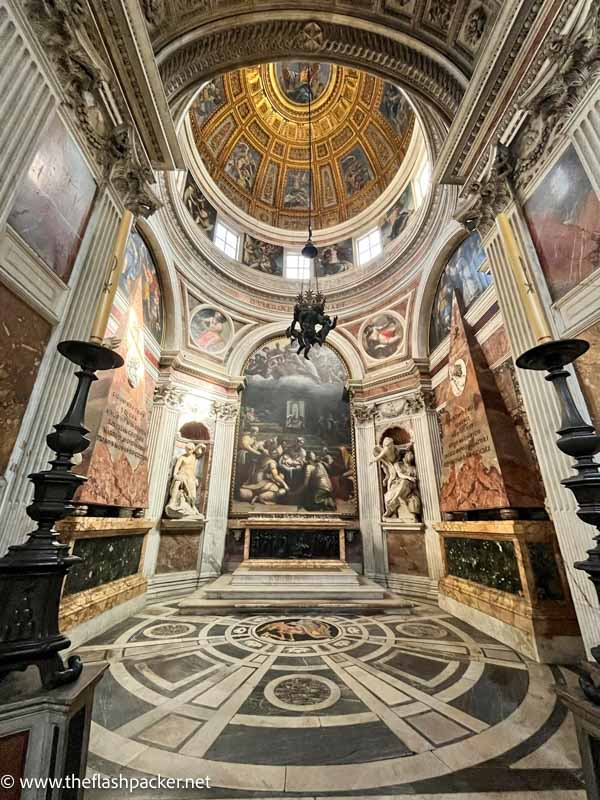
The church itself was founded in 1099 on the site of Nero’s grave, was rebuilt by Pope Sixtus IV in 1472 and later extended by Bernini and Bramante.
29. Great Synagogue of Rome (Tempio Maggiore di Roma)
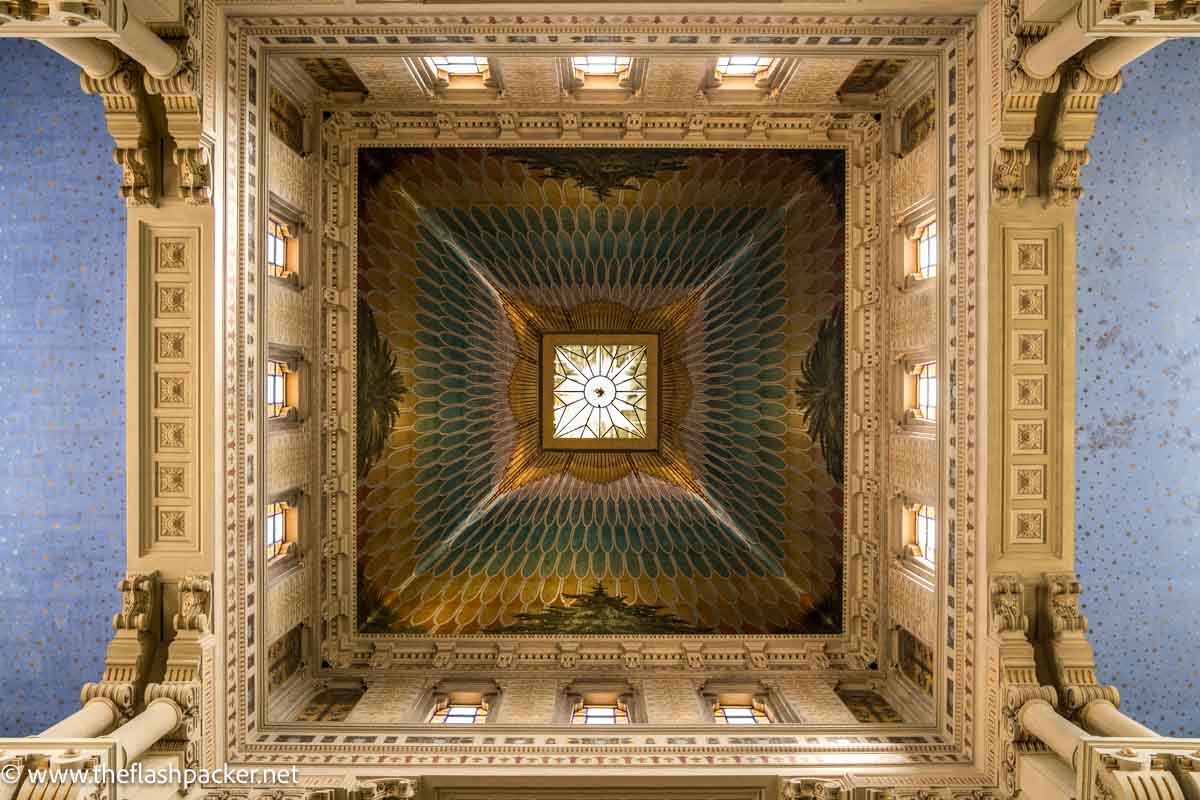
My Roman friends insisted I went to the Great Synagogue of Rome when I last visited and I am very glad that they did.
Located in the former ghetto and inaugurated in 1904, the Great Synagogue is one of the largest of its kind. With its aluminium-clad dome and Art Nouveau decoration, it is magnificent.
You can visit the synagogue through the Jewish Museum. Guided tours are available in different languages.
Gorgeous Gardens
With its crowds and chaotic air, Rome can feel overwhelming, especially if you are a first-time visitor. Therefore, it’s good to have a few gardens up your sleeve.
30. Villa Borghese Gardens
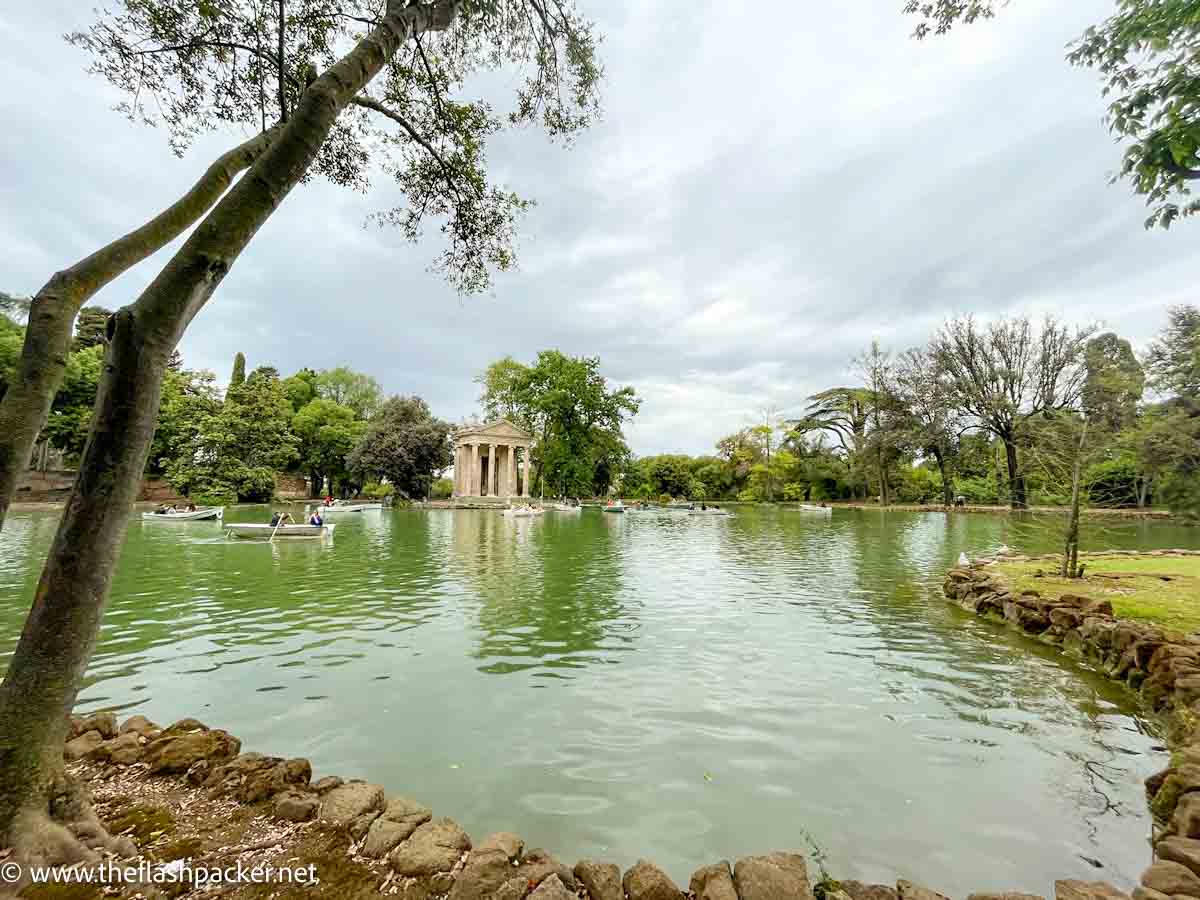
Developed as the backyard for Villa Borghese, these are the most popular gardens in Rome and the city’s green lung.
This former vineyard contains a zoo (Bioparco di Roma), a famous water clock, Italy’s answer to London’s Globe Theatre and a replica of the ancient Temple of Ascelpius set on an island in a boating lake.
Villa Borghese Gardens are open from dawn to dusk every day.
32. Orange Garden (Giardino degli Aranci)
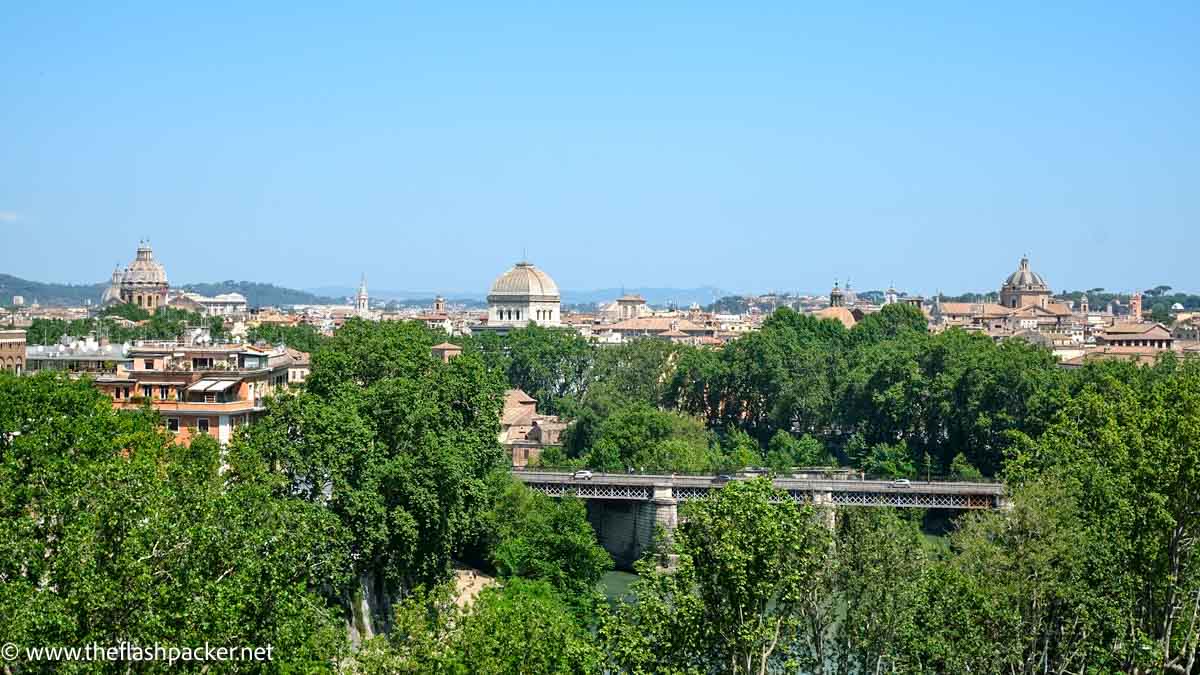
For one of the best viewpoints in Rome, head to the Orange Garden.
Sitting on top of the Aventine Hill, this chilled public garden is planted with orange and pine trees. It was established in 1932 for the Dominican Order of the church of Santa Sabina, which is adjacent to the garden.
Its official name is Parco Savello and it is open year-round from 7 am until dusk. Entry is free.
33. Rose Garden (Il Roseto di Roma)
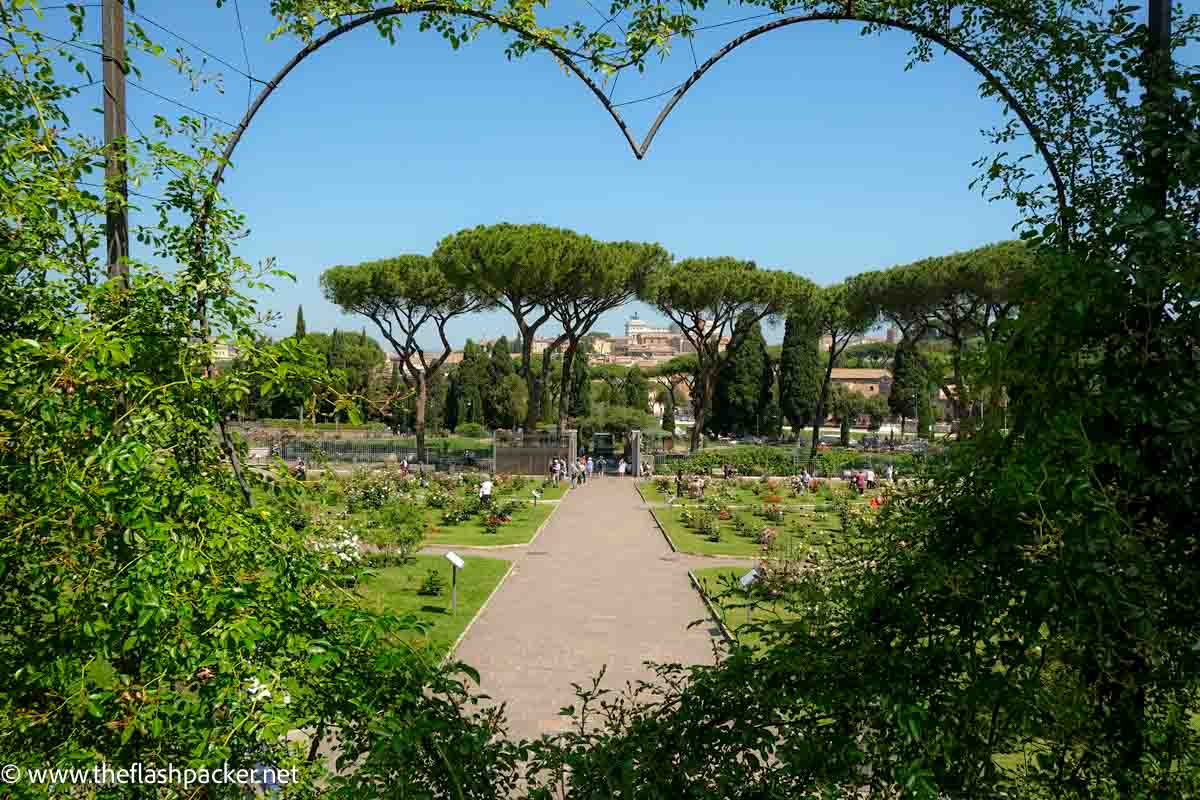
On the slopes of the Aventine is the lovely Municipal Rose Garden.
It is home to over 1,000 species of roses from across the globe and there are iconic views of Rome.
Il Roseto is open during spring flowering (late April to May) and during autumn flowering in October. Entry is free.
Quirky Rome Landmarks
Finally, let’s move away from the obvious – and most of the crowds – and take a look at these more under-the-radar landmarks of Rome.
34. La Bocca della Verità
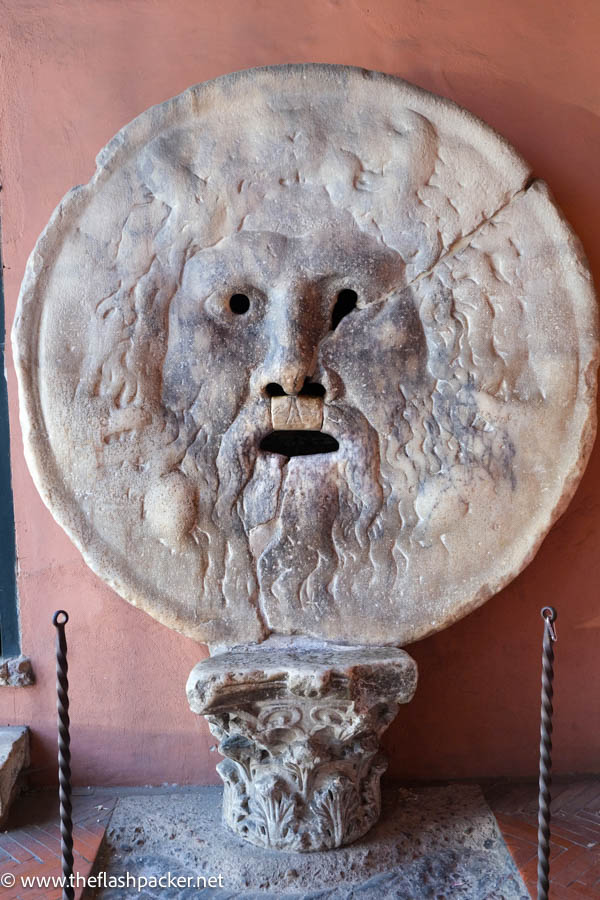
Do you remember that scene in Roman Holiday in which Audrey Hepburn’s character gingerly places her hand into the mouth of a stone sculpture?
This is La Bocca della Verità, or The Mouth of Truth, the weather-beaten stone face of the sea god Oceanus that stands in the portico of the church of Santa Maria in Cosmedin. Legend has it that if you stick your hand in its stone mouth as a liar, it will bite off your hand.
35. Capuchin Crypt
Visit the Church of the Cappucini, or Santa Maria della Concezione, for one of Rome’s most macabre sights. Within the church’s five subterranean chapels are the bones and skeletons of over 4,000 Capuchins, arranged in patterns.
For the Capuchin order, this represents a poignant reminder of our mortality and the passage of life on Earth. To me, it’s a bizarre form of interior design.
36. Stadio dei Marmi
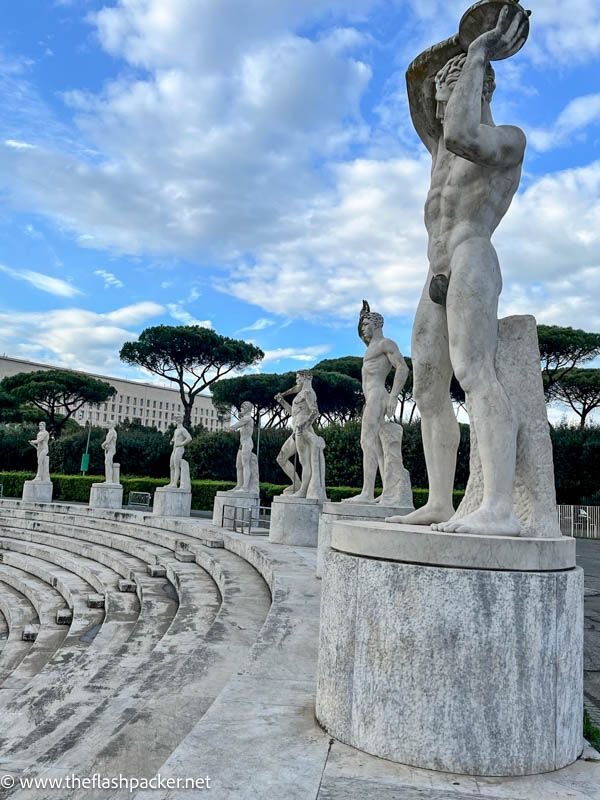
Built to celebrate Fascist accomplishments and the Gioventú del Littorio, the youth movement of the National Fascist Party of Italy, the Stadio dei Marmi first opened in 1932 under the guiding hand of Benito Mussolini. This colossal sports stadium was initially named Foro Mussolini.
This is one of the best examples of fascist architecture in Rome. The stadium is encircled by sixty, towering statues of athletes sculpted from Carrara marble.
Whatever your views are on retaining Fascist architecture, this nonetheless represents an important period of Italy’s history.
37. EUR
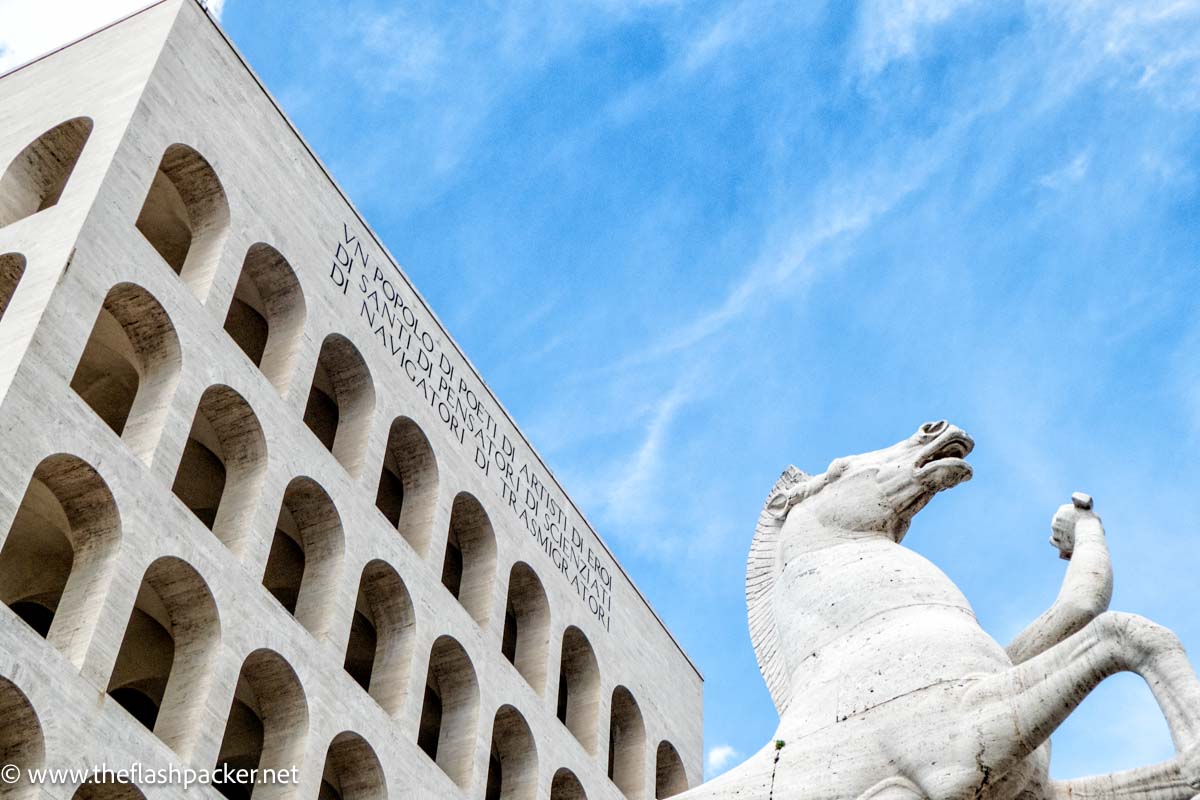
EUR is a little off the beaten track and is a stark contrast to the city’s squares, museums and churches. It is not a Rome attraction that you will find listed in many guidebooks.
Esposizione Universale Romana, known by its acronym EUR, was a vanity project of Mussolini and his Fascist party. This new suburb was intended for a Universal Exhibition celebrating Fascist Italy but was abandoned when World War II broke out.
Inspired by classic Roman city planning, EUR is one of the most prominent examples of fascist urban planning and architecture in Italy. It features wide boulevards and towering, square buildings, built from marble and travertine to resemble temples and buildings of the Roman Empire.
This so-called rationalist architecture is epitomised by the Palazzo della Civiltà Italiana, known as the Square Colosseum.
The whole area has a weird Orwellian vibe but is worth visiting if you have more than a few days in Rome. And you will be able to pretty much guarantee that it is unlikely that there will be few other tourists there
And that’s a wrap!
Rome is not only one of the best places to visit in Italy but it is also an excellent destination for solo travellers, even if you are travelling alone for the first time. You can walk in the steps of Ancient Romans, gaze in awe at the ceiling of the Sistine Chapel and sip an Aperol Spritz on one of its sun-drenched piazze.
But whichever Rome landmark you choose to visit, you can’t go far wrong. Together they paint a rich picture of almost three millennia of architecture, history and culture.
READ THIS NEXT: 25 Famous Landmarks in Florence, Italy That You Must Visit

About Bridget
Bridget Coleman has been a passionate traveller for more than 30 years. She has visited 70+ countries, most as a solo traveller.
Articles on this site reflect her first-hand experiences.
To get in touch, email her at hello@theflashpacker.net or follow her on social media.

